Risk-Based Capital Reporting for Institutions Subject to the Advanced Capital Adequacy Framework
Advanced Capital Adequacy Framework Regulatory Reporting Requirements
FFIEC101instruction04.22.2008
Risk-Based Capital Reporting for Institutions Subject to the Advanced Capital Adequacy Framework
OMB: 7100-0319
FFIEC 101
Reporting Instructions for Schedules A through S
INSTRUCTIONS FOR PREPARATION OF
FFIEC 101 – Risk-Based Capital Reporting for Institutions Subject to the Advanced Capital Adequacy Framework
TABLE OF CONTENTS
General Instructions
Schedule A: Advanced Risk-Based Capital
Part 1: Risk-Based Capital Numerator and Ratios for Banks and Bank Holding Companies
Part 2: Risk-Based Capital Numerator and Ratios for Savings Associations
Schedule B: Summary Risk-Weighted Asset Information for Banks Approved to Use Advanced Internal Ratings-Based and Advanced Measurement Approaches for Regulatory Capital Purposes
Schedule C: Wholesale Exposure - Corporate
Schedule D: Wholesale Exposure – Bank
Schedule E: Wholesale Exposure – Sovereign
Schedule F: Wholesale Exposure – IPRE
Schedule G: Wholesale Exposure – HVCRE
Schedule H: Wholesale Exposure – Eligible Margin Loans, Repo-Style Transactions and OTC Derivatives (With Cross-Product Netting)
Schedule I: Wholesale Exposure – Eligible Margin Loans, Repo-Style Transactions (No Cross-Product Netting)
Schedule J: Wholesale Exposure – OTC Derivatives (No Cross-Product Netting)
Schedule K: Retail Exposure – Residential Mortgage – Closed-end First Lien Exposures
Schedule L: Retail Exposure – Residential Mortgage – Closed-end Junior Lien Exposures
Schedule M: Retail Exposure – Residential Mortgage – Revolving Exposures
Schedule N: Retail Exposure – Qualifying Revolving Exposures
Schedule O: Retail Exposure – Other Retail Exposures
TABLE OF CONTENTS (Continued)
Schedule P: Securitization Exposures Subject to the Ratings-Based or Internal Assessment Approaches
Schedule Q: Securitization Detail Schedule
Schedule R: Equity Exposures
Schedule S: Operational Risk
GENERAL INSTRUCTIONS
Who Must Report
A. Scope and Reporting Criteria
For purposes of this report, each bank, BHC, and savings association that applies the Advanced Capital Adequacy Framework must submit a report. For purposes of this report, the Advanced Capital Adequacy Framework1 is referred to as the “final rule” throughout these instructions.
B. Shifts in Reporting Status
The institutions specified above in section A must begin reporting FFIEC 101 data at the end of the first quarter in which they have begun their parallel run period. During its parallel run and the three year transitional floor periods, the institution will continue to file the regulatory capital schedule in its Call Report, FR Y-9C, or TFR, as well as the FFIEC 101.
If an opt-in institution decides that it will no longer use the advanced approaches for regulatory capital purposes, it should consult with its primary Federal supervisor before adopting another approach. Reporting of FFIEC 101 data should continue until the primary Federal supervisor agrees that reporting is no longer necessary.
What Must Be Reported
Reporting Schedules and Instructions
The information contained in the attached reporting schedules must be completed in accordance with the instructions accompanying these schedules. The schedules and instructions are collectively referred to as FFIEC Form 101.
D. Organization of the Instructions
These instructions cover the FFIEC 101 report schedules. They are divided into the following sections:
The General Instructions that describe overall reporting requirements.
Line item instructions for each schedule of the FFIEC 101.
The instructions and definitions in (1) and (2) are not necessarily self-contained; reference to the final rule may be needed for more detailed definitions and regulatory capital treatments under the advanced approaches.
Where to Submit the Reports
E. Electronic Submission
All reporting institutions must submit their completed reports electronically. Reporting institutions should contact their primary Federal supervisor for procedures for electronic submission. Each bank is responsible for ensuring that the data reported each quarter reflects fully and accurately the item reporting requirements for that report date, including any changes that may be made from time to time. This responsibility cannot be transferred or delegated to software vendors, servicers, or others outside the reporting entity.
F. Frequency of Reporting
Each reporting institution must submit a report as of the end of each quarter on a calendar year basis. The “as-of” date for each reporting period is March 31, June 30, September 30 and December 31 of each calendar year.
G. When to Submit the Reports
During an institution’s parallel run (as defined in the final rule), the information contained in this report must be submitted to the primary Federal supervisor 60 days after the as-of date. That is, the March 31 report must be submitted by May 30, the June 30 report is due by August 29, the September 30 report is due by November 29, and the December 31 report is due by March 1 (or February 29 if a leap year) of the subsequent year. After completion of the parallel run, the submission date for each report will be the same date as required by the Call Report, FR Y-9C and TFR for each bank, BHC, and savings association, respectively. If the submission deadline falls on a weekend or holiday, the report must be received on the first business day after the Saturday, Sunday, or holiday.
The reports are due by the end of the reporting day on the submission date (5:00 P.M.).
H. Preparation of the Reports
Each reporting institution must prepare and file the FFIEC 101 report in accordance with the instructions provided. All reports must be prepared in a consistent manner.
Note that there are two separate schedules for reporting of risk-based capital numerator and ratio items (Schedule A): Part 1 for banks and bank holding companies, and Part 2 for savings associations. All remaining schedules (schedules B through S) contain common data items to be completed by banks, bank holding companies, and savings associations.
Questions and requests for interpretations of matters appearing in any part of the instructions should be addressed to the reporting entity’s primary Federal supervisor. Regardless of whether a reporting entity requests an interpretation of a matter appearing in these instructions, when the reporting entity’s primary Federal supervisor’s interpretation of the instructions differs from that of the reporting entity, the Federal supervisor may require the reporting entity to prepare its FFIEC 101 report in accordance with its interpretation and may require amended filings for previously submitted reports.
I. Rounding
For banking organizations with total assets of less than $10 billion, all dollar amounts must be reported in thousands, with the figures rounded to the nearest thousand. Items less than $500 will be reported as zero. For banking organizations with total assets of $10 billion or more, all dollar amounts may be reported in thousands, but each banking organization, at its option, may round the figures reported to the nearest million, with zeroes reported in the thousands column. For banking organizations exercising this option, amounts less than $500,000 will be reported as zero.
Report to two decimal places any “weighted averages” required to be reported in this report.
J. Negative Entries
Except as indicated in the reporting instructions for specific reporting items, negative entries are generally not appropriate in this report.
Every reporting item on the report will be granted confidential treatment during an institution’s parallel run period. For reports that an institution files after its parallel run period, all items reported on Schedules A and B (and items 1 and 2 only of the operational risk schedule) will be available to the public. All other items will be confidential. However, a reporting institution may request confidential treatment for all or some of the portions of this report that will be made available to the public after an institution’s parallel run period if the institution is of the opinion that disclosure of specific commercial or financial information in the report would likely result in substantial harm to its competitive position, or that disclosure of the submitted information would result in unwarranted invasion of personal privacy. In certain limited circumstances the primary Federal supervisor may approve confidential treatment of some or all of the items requested if the institution has clearly provided a compelling justification for the request. A request for confidential treatment must be submitted in writing prior to the electronic submission of the report. The request must discuss in writing the justification for which confidentiality is requested and must demonstrate the specific nature of the harm that would result from public release of the information. Merely stating that competitive harm would result or that information is personal is not sufficient. Information for which confidential treatment is requested may subsequently be released by the primary Federal supervisors if it determines that the disclosure of such information is in the public interest.
L. Verification and Signatures
Verification. All additions and subtractions should be double-checked before reports are submitted. Totals and subtotals in supporting materials should be cross-checked to any applicable corresponding items elsewhere in the reports.
Signatures. The report must be signed by a senior officer of the reporting entity who can attest that the risk estimates and other information submitted in this report meet the requirements set forth in the final rule and the reporting instructions of this report. The senior officer may be the chief financial officer, the chief risk officer, or equivalent senior officer. The cover page of this report form should be used to fulfill the signature and attestation requirement and should be attached to the printout placed in the reporting institution’s files.
M. Amended Reports
The agencies may require the filing of amended reports if reports as previously submitted contain
significant errors. In addition, a reporting institution must file an amended report when it discovers significant errors or omissions subsequent to submission of a report.
N. Retention of Reports
In general, a reporting entity should maintain in its files a signed and attested record of its completed FFIEC 101 report, including any amended reports, and the related work papers and supporting documentation for five years after the report date, unless there are applicable state requirements that mandate a longer retention time.
O. Consolidation
Exposure amounts and risk weighted asset amounts should be reported on a consolidated basis using the same consolidation rules applied to the bank’s Call Report, FR Y-9C, or TFR.
Schedule A - ADVANCED RISK-BASED CAPITAL
Part 1: Risk-Based Capital Numerator and Ratios for Banks and Bank Holding Companies
Banks and bank holding companies must report risk-based capital numerator and ratio items on Schedule A – Advanced Risk Based Capital (Calculation of Numerator and Ratios for Banks and Bank Holding Companies). Savings associations should report risk-based capital numerator and ratio information on Schedule A – ADVANCED RISK-BASED CAPITAL (Calculation of Numerator and Ratios for Savings Associations). See Part 2 of this section for instructions to this schedule.
General Instructions
Definitions. Apply the definitions provided in the final rule for the following terms: (1) eligible credit reserves; (2) expected credit losses (ECL); (3) gain-on-sale; (4) credit risk weighted assets; (5) tier 1 capital; (6) tier 2 capital; (7) total risk-weighted assets; and (8) total qualifying capital.
Tier 2 carryover is any amount deductible from tier 2 capital that exceeds the banking organization’s actual tier 2 capital.
Schedule R for purposes of these reporting instructions refers to Schedule RC-R of the FFIEC 031 and 041 bank Call Report, and Schedule HC-R of the BHC FR Y-9C report.
Item Instructions
Item No. Caption and Instructions
Tier 1 Capital
1 Total equity capital. Report the amount of the banking organization’s total equity capital as reported in Schedule RC of the Call Report or Schedule HC of the FR Y-9C.
2 LESS: Net unrealized gains (losses) on available-for-sale securities. Report in this item the amount reported on Schedule R of the Call Report (FFIEC 031 or 041) or the BHC FR Y-9C.
3 LESS: Net unrealized losses on available-for-sale equity securities. Report in this item the amount reported on Schedule R of the Call Report (FFIEC 031 or 041) or the BHC FR Y-9C.
4 LESS: Accumulated net gains (losses) on cash flow hedges. Report in this item the amount reported on Schedule R of the Call Report (FFIEC 031 or 041) or the BHC FR Y-9C.
5 LESS: Nonqualifying perpetual preferred stock. Report in this item the amount reported on Schedule R of the Call Report (FFIEC 031 or 041) or the BHC FR Y-9C.
6a Qualifying minority interests in consolidated subsidiaries. Report in this item the amount reported on Schedule R of the Call Report (FFIEC 031 or 041) or the BHC FR Y-9C.
6b Qualifying trust preferred securities. NOTE: Item 6b is only to be reported by bank holding companies (BHCs). Report in this item the amount reported on Schedule R of the FR Y-9C.
7a LESS: Disallowed goodwill and other disallowed intangible assets. Report in this item the amount reported on Schedule R of the Call Report (FFIEC 031 or 041) or the BHC FR Y-9C.
7b LESS: Cumulative change in fair value of all financial liabilities accounted for under a fair value option that is included in retained earnings and is attributable to changes in the bank’s own creditworthiness. Report in this item the amount reported on Schedule R of the Call Report (FFIEC 031 or 041) or the BHC FR Y-9C.
8 Subtotal. Report the sum of items 1 and 6a (and 6b for BHCs) less items 2, 3, 4, 5, 7a, and 7b.
9a LESS: Disallowed servicing assets and purchased credit card relationships. Report in this item the amount reported on Schedule R of the Call Report (FFIEC 031 or 041) or the BHC FR Y-9C.
9b LESS: Disallowed deferred tax assets. Report in this item the amount reported on Schedule R of the Call Report (FFIEC 031 or 041) or the BHC FR Y-9C.
9c LESS: Shortfall of eligible credit reserves below total expected credit losses (50% of the shortfall plus any tier 2 carryover). Report 50 percent of the amount by which total expected credit losses exceed eligible credit reserves in this item (plus any tier 2 carryover associated with this amount).
9d LESS: Gain-on-sale associated with securitization exposures. Report gain-on-sale associated with securitization exposures.
9e LESS: Certain failed capital markets transactions. Report in this item 50% of the current market value of the deliverables owed to the banking organization for non-delivery-versus-payment (non-DvP) and non-payment-versus-payment (non-PvP) transactions (with a normal settlement period) where the banking organization has not received the deliverables by the fifth business day after counterparty delivery was due.
9f LESS: Other securitization deductions. Report in this item 50% of all non-gain-on-sale securitization exposures required to be deducted from capital under the final rule.
A banking organization may calculate any deductions from regulatory capital with respect to a securitization exposure (including after-tax gain-on-sale) net of any deferred tax liabilities associated with the exposure.
10a LESS: Insurance underwriting subsidiaries’ minimum regulatory capital (for BHCs only). For BHCs with consolidated insurance underwriting subsidiaries that are functionally regulated by a state insurance regulator (or subject to comparable supervision and regulatory capital requirements in a non-U.S. jurisdiction), report in this item 50% of the insurance underwriting subsidiary’s minimum regulatory capital requirement as determined by its functional (or equivalent) regulator, plus any tier 2 carryover. For U.S. regulated insurance subsidiaries, this amount is generally 200 percent of the subsidiary’s Authorized Control Level as established by the appropriate state insurance regulator.
10b Other additions to (deductions from) Tier 1 capital. Report the amount of any additions to or deductions from tier 1 capital based on the capital guidelines of the banking organization's primary Federal supervisor that are not included in items 1 through 10a above. If the amount to be reported in this item is a net deduction, enclose the amount in parentheses.
Banks with financial subsidiaries should exclude from this item adjustments to tier 1 capital for the deconsolidation of such subsidiaries. Adjustments to tier 1 capital for financial subsidiaries should be reported in item 23a below.
11 Tier 1 capital. Report the sum of items 8 and 10b, less items 9a through 10a. If a bank has no financial subsidiaries, the amount reported in this item is the numerator of the bank's tier 1 risk-based capital ratio.
Tier 2 Capital
12 Qualifying subordinated debt and redeemable preferred stock. Report in this item the amount reported on Schedule R of the bank Call Report (FFIEC 031 or 041) or the BHC FR Y-9C.
13 Qualifying cumulative perpetual preferred stock includible in Tier 2 capital. Report in this item the amount reported on Schedule R of the bank Call Report (FFIEC 031 or 041) or the BHC FR Y-9C.
14 Excess of eligible credit reserves over total expected credit losses (up to 0.60% of credit risk-weighted assets). If eligible credit reserves exceed total ECL, then report in this item the amount by which eligible credit reserves exceed ECL, up to a maximum amount of 0.60 percent of credit-risk-weighted assets.
15 Unrealized gains on available-for-sale equity securities includible in Tier 2 capital. Report in this item the amount reported on Schedule R of the bank Call Report (FFIEC 031 or 041) or the BHC FR Y-9C.
16a LESS: Insurance underwriting subsidiaries’ minimum regulatory capital (for BHCs only). Report in this item 50% of the insurance underwriting subsidiary’s minimum regulatory capital requirement as described in item 10a above. If the amount deductible from tier 2 capital exceeds the BHC’s actual tier 2 capital, the BHC must report the excess in item 10a above.
16b Other additions to (deductions from) Tier 2 capital. Report the amount of any items that qualify for inclusion in tier 2 capital based on the capital guidelines of the banking organization's primary Federal supervisor that are not included in items 12 through 16a, above.
.
Adjustments to Tier 2 capital
17a LESS: Shortfall of eligible credit reserves below total expected credit losses (up to the lower of 50 percent of the shortfall or amount of tier 2 capital). Report in the item 50 percent of any shortfall of eligible credit reserves below total expected credit losses as described in item 9c above. If the amount exceeds the banking organization’s actual tier 2 capital, the banking organization must report the excess in item 9c above.
17b LESS: Certain failed capital markets transactions (up to the lower of 50% of deductions from such failed transactions or amount of tier 2 capital). Report in this item 50% of certain failed capital markets transactions as described in item 9e above. If the amount exceeds the banking organization’s actual tier 2 capital, the banking organization must report the excess in item 9e above.
17c LESS: Other securitization deductions (up to the lower of 50% of deductions or amount of tier 2 capital). Report in this item 50% of all non-gain-on-sale securitization exposures required to be deducted from capital under the final rule.
18 Tier 2 capital. Report the sum of items 12 through 15 and 16b, less items 16a and items 17a through 17c.
19 Allowable Tier 2 capital. Report the amount of the banking organization's allowable tier 2 capital. The maximum amount of tier 2 capital that is allowable in the banking organization’s qualifying total capital is 100 percent of tier 1 capital. The amount reported in this item must be the lesser of item 11and item 18 if item 11 is a positive number. If item 11 is a negative number, report a zero in this item.
20 Tier 3 capital allocated for market risk. Report in this item the amount reported on Schedule R of the bank Call Report (FFIEC 031 or 041) or the BHC FR Y-9C.
21 LESS: Deductions for total risk-based capital. Report in this item the amount reported on Schedule R of the bank Call Report (FFIEC 031 or 041) or the BHC FR Y-9C.
22 Total risk-based capital. Report the sum of items 11, 19, and 20, less item 21. The amount reported in this item is the numerator of the banking organization’s total risk-based capital ratio.
Adjustments for financial subsidiaries
Items 23a through 24 and column A of items 25 and 26 are only to be completed by banks with “financial subsidiaries” as defined by the Gramm-Leach-Bliley Act of 1999.
23a Adjustment to Tier 1 capital. Report in this item the amount reported on Schedule R of the bank Call Report (FFIEC 031 or 041).
23b Adjustment to total risk-based capital. Report in this item the amount reported on Schedule R of the bank Call Report (FFIEC 031 or 041).
24 Adjustment to risk-weighted assets. Report in this item the amount reported on Schedule R of the bank Call Report (FFIEC 031 or 041).
25 Tier 1 risk-based capital ratio. Report the banking organization’s tier 1 risk-based capital ratio as a percentage. Column B is to be completed by all banking organizations. The ratio for column B is determined by dividing item 11 by total risk weighted assets (from Schedule B, item 33).
Only banks with financial subsidiaries must also complete column A. The ratio for column A is determined by dividing item 11 (minus item 23a) by adjusted total risk weighted assets (Schedule B, item 33 minus item 24 of this schedule).
26 Total risk-based capital ratio. Report the banking organization’s total risk-based capital ratio as a percentage. Column B is to be completed by all banking organizations. The ratio for column B is determined by dividing item 22 by total risk weighted assets (from Schedule B, item 33).
Only banks with financial subsidiaries must also complete column A. The ratio for column A is determined by dividing item 22 (minus item 23b) by adjusted total risk weighted assets (Schedule B, item 33 minus item 24 of this schedule).
27 Eligible credit reserves. Report the amount of eligible credit reserves.
28 Total expected credit losses. Report the amount of total expected credit losses (ECL).
Part 2: Risk-Based Capital Numerator and Ratios for Savings Associations
Savings associations should report risk-based capital numerator and ratio information on Schedule A – ADVANCED RISK-BASED CAPITAL (Calculation of Numerator and Ratios for Savings Associations). Banks and bank holding companies must report risk-based capital numerator and ratio items on Schedule A – Advanced Risk Based Capital (Calculation of Numerator and Ratios for Banks and Bank Holding Companies). See Part 1 of this section for instructions to this schedule.
General Instructions
Definitions. Apply the definitions provided in the final rule for the following terms: (1) eligible credit reserves; (2) expected credit losses; (3) tier 2 carryover; (4) gain-on-sale; (5) credit risk weighted assets; (6) tier 1 capital; (7) tier 2 capital; (8) total risk-weighted assets; and (9) total qualifying capital.
Item Instructions
Item No. Caption and Instructions
Tier 1 Capital
1 Total Equity Capital. Report the amount of Total Equity Capital.
General note for items 2 through 9: Report positive balances for each of these items. You will deduct each of these items when you calculate Tier 1 capital for item 14.
2 Investments in and Loans to Nonincludable Subsidiaries. Reduce tier 1 (core) capital by your investment in, loans to, and guaranteed obligations of certain nonincludable subsidiaries.
In consolidation, you eliminate the investment and intercompany loan accounts of subsidiaries on Schedule SC. Therefore, you must obtain the amount of the investment and advances from your books before consolidation. Calculate the investment using the equity method as prescribed by GAAP plus any loans, advances, guaranteed obligations, or other extensions of credit, whether secured or unsecured. Use negative investments to offset loans, guaranteed obligations, or advances to the same subsidiary, but do not reduce this item below zero. If you have a nonincludable subsidiary and the result on this item rounds to zero or is a negative amount, report a one to indicate that you have reported your nonincludable subsidiary.
Nonincludable Subsidiaries
Section 5(t)(5)(a) of HOLA [12 USC 1464(t)(5)(A)] requires a savings association to deduct investments and extensions of credit to its subsidiary that engages in activities impermissible for a national bank with the following exceptions:
Subsidiaries solely engaged in impermissible activities as an agent for its customers where the subsidiary has no risk of loss.
Subsidiaries engaged solely in mortgage banking activities.
Insured depository institutions acquired as subsidiaries before May 1, 1989.
Subsidiaries of federal savings associations that existed on August 9, 1989, and were chartered before October 15, 1982, as a savings bank or cooperative bank under state law.
Subsidiaries of federal savings associations that existed on August 9, 1989, that acquired their principal assets from a savings association chartered before October 15, 1982, as a savings bank or cooperative bank under state law.
Generally, a subsidiary of a savings association is nonincludable if any of its activities are impermissible for a national bank. If any lower-tier subsidiary engages in impermissible activities or invests in an entity that engages in impermissible activities, but the first-tier subsidiary owned by the parent savings association does not directly engage in impermissible activities, the first-tier subsidiary is an includable subsidiary. Deduct your investment and loans (and guarantees) in the nonincludable lower-tier subsidiary in computing the capital of the upper-tier subsidiary on an unconsolidated basis and in computing your consolidated capital. Fully deduct all nonincludable subsidiaries from capital.
You should report investments in and advances to nonincludable subsidiaries net of all general valuation allowances, specific valuation allowances, and charge‑offs, as they have already reduced equity capital.
3 Goodwill and Certain Other Intangible Assets. This item will generally equal SC660 with the exception of certain intangible assets such as intangible pension assets and computer software. You may change this amount in certain cases. For purposes of regulatory capital only, you may reduce the amount of core deposit premiums and certain other intangible assets that you acquired in a nontaxable business combination by any corresponding deferred tax liabilities.
Include:
Core deposit intangible assets (CDIs).
Purchased credit card relationships, (PCCRs).
Favorable leaseholds
Do not include:
Servicing assets.
Certain nonsecurity financial instruments accounted for under FASB Statement No. 125.
Net deferred tax assets.
4 Disallowed Servicing Assets, Disallowed Deferred Tax Assets, and Other Disallowed Assets
Disallowed Servicing Assets
Generally, you may include servicing assets reported on SC642 and SC644 in regulatory capital, subject to both of the following limitations:
For mortgage and nonmortgage servicing assets, and PCCRs, combined — include in capital the lesser of:
100 percent of Tier 1 (core) capital.
90 percent of fair value.
100 percent of reported amount.
For nonmortgage servicing assets and PCCRs, as a separate sub-limit — include in capital the lesser of the following:
25 percent of Tier 1 (core) capital.
90 percent of fair value.
100 percent of reported amount.
Accordingly, on item 4, include the amount of servicing assets reported on SC642 and SC644 (that are not in a nonincludable subsidiary) and PCCRs included on SC660 that exceed the above limitations.
For purposes of the 25 percent and 100 percent of tier 1 (core) capital limitations above, base the deduction on a tier 1 (core) capital subtotal before the deduction. In addition, in computing the deduction for the 25 percent and 100 percent limitations, you may reduce the amount of servicing assets by any corresponding deferred tax liability.
Disallowed Deferred Tax Assets
Generally, if regulatory capital includes disallowed deferred tax assets, include the amount of the disallowed deferred tax assets in this item. To the extent that realizing deferred tax assets depends on your future taxable income (exclusive of reversing temporary differences and carryforwards), or your tax planning strategies, such deferred tax assets are limited for regulatory capital purposes to the lesser of the following:
The amount that you can realize within one year.
10 percent of Tier 1 (core) capital.
Accordingly, disallowed deferred tax assets is that amount includable in assets under GAAP, but not includable in regulatory capital pursuant to OTS policy. The deferred tax asset subject to the limitation is the net deferred tax asset or liability included on Schedule SC, adjusted for the deferred tax asset or liability added to or subtracted from total assets related to the following:
Accumulated gains and losses on certain AFS securities and cash flow hedges on item 10 (CCR180).
Goodwill and other intangible assets on Schedule CCR, lines 265 and 285.
Servicing assets on Schedule CCR, line 270.
Note: You can generally realize deferred tax assets without limitation from the following sources:
Taxes paid in prior carry‑back years.
Future reversals of existing taxable temporary differences.
For purposes of the 10 percent of tier 1 (core) capital limitation above, base the deduction on a tier 1 (Core) capital subtotal before the deduction.
5 Shortfall of Eligible Credit Reserves Below Total Expected Credit Losses (50% of Shortfall Plus Tier 2 Carryover). Eligible credit reserves are defined as all general allowances, including the ALLL, that have been established through a charge against earnings to absorb credit losses associated with on- or off-balance sheet wholesale and retail exposures. Eligible credit reserves would not include other specific reserves created against recognized losses.
A thrift’s total expected credit losses (ECL) is the sum of the ECL for all wholesale and retail exposures other than exposures to which the thrift has applied double default treatment. The thrift’s ECL for a wholesale exposure to a non-defaulted obligor or for a segment of non-defaulted retail exposures that is carried at fair value with gains and losses flowing through earnings or that is classified as held-for-sale and is carried at the lower of cost or fair value with losses flowing through earnings is zero. For all other wholesale exposures to non-defaulted obligors or segments of non-defaulted retail exposures, the product of PD times LGD times EAD for the exposure or segment. The thrift’s ECL for a wholesale exposure to a defaulted obligor or a segment of defaulted retail exposures is equal to the thrift’s impairment estimate for allowance purposes for the exposure or segment.
A shortfall is created when the total dollar amount of ECL exceeds the thrift’s eligible credit reserves. If there is a shortfall of eligible credit reserves compared to ECL, the thrift must deduct 50 percent of the shortfall from tier 1 capital and 50 percent from tier 2 capital. If the amount deductible from tier 2 capital exceeds the thrift’s actual tier 2 capital, the thrift would deduct the excess from tier 1 capital (this amount is referred to as the tier 2 carryover).
6 Gain-on-Sale Associated with Securitization Exposures. A thrift must deduct from tier 1 capital any increase in the thrift’s equity capital at the inception of a securitization transaction (gain-on-sale), other than an increase in equity capital that results from the thrift’s receipt of cash in connection with the securitization. Under SFAS No. 140, an institution initially measures and records assets retained in connection with a sale or securitization, based on relative fair values. That is, the institution allocates the previous carrying amount between the sold assets and the retained interests based on their relative fair values. The reported gain is the difference between the net proceeds from the sale and the allocated carrying value of the assets sold. This methodology is often called “gain-on-sale” accounting. For example, a thrift would deduct a gain attributable to a credit-enhancing interest-only strip (CEIO) that results from FAS 140 accounting treatment for the sale of underlying exposures to a securitization special purpose entity (SPE). A thrift must deduct these interests in securitizations from Tier 1 to the extent they represent gain-on-sale. A thrift must deduct any remaining CEIOs 50 percent from tier 1 capital and 50 percent from tier 2 capital. Any remaining CEIOs (that do not represent gain-on-sale) should be deducted from tier 1 capital in item 8 below, and any remaining Tier 2 deductions should be reported in item 22 below.
7 Certain Failed Capital Markets Transactions (up to the lower of 50% of shortfall or amount of Tier 2 capital). Deduct in this item 50% of your exposure on certain unsettled and failed transactions (50 percent from tier 1 and 50 percent from tier 2). These transactions include non-delivery-versus-payment (non DvP) and non-payment-versus-payment (non-PvP) transactions (with a normal settlement period) where the thrift has not received the deliverables by the fifth business day after counterparty delivery was due. In these instances, the thrift must deduct the current market value of the deliverables owed to the thrift 50 percent from tier 1 and 50% from tier 2 capital. (See item 21).
If the amount deductible from tier 2 capital exceeds the thrift’s actual tier 2 capital, the thrift would deduct the excess from tier 1 capital.
8 Other Securitization Deductions (50% of Deductions Plus Tier 2 Carryover). Certain other securitization exposures are also deducted from tier 1 and tier 2 capital. These exposures include any securitization that (1) does not qualify for the Ratings-Based Approach, the Internal Assessment Approach, or the Supervisory Formula Approach; (2) securitizations of non-IRB exposures (i.e. exposures that are not a wholesale exposure, retail exposure, or securitization exposure, or equity exposure); (3) low-rated securitization exposures that qualify for and must be deducted under the Ratings-Based Approach; and (4) High-risk exposures under the Supervisory Formula Approach. When a thrift must deduct a securitization exposure (other than gain-on-sale) from regulatory capital, the thrift must take the deduction 50 percent from tier 1 capital and 50 percent from tier 2 capital. Report in this item any remaining tier 1 deductions for CEIOs (that do not represent gain-on-sale). Refer also to item 22.
If the amount deductible from tier 2 capital exceeds the thrift’s actual tier 2 capital, the thrift would deduct the excess from Tier 1 capital in this item.
A thrift may calculate any deductions from regulatory capital with respect to a securitization exposure (including after-tax gain-on-sale) net of any deferred tax liabilities associated with the exposure.
9 Other. Report other items deducted from tier 1 capital not included in items 2 through 8. For example, OTS capital rules do not include cumulative perpetual preferred stock in tier 1 (core) capital.
10 Accumulated Losses (Gains) on Certain Available-For-Sale Securities and Cash Flow Hedges, Net of Taxes.
Report in this item:
1. Accumulated Unrealized Gains and Losses on Certain Available-for-Sale Securities
Equity capital on SC80 includes a separate component for accumulated, unrealized gains and losses, net of income taxes, on AFS securities. See SC860, Unrealized Gains (Losses) on Available-for-sale Securities. However, you cannot include most of that separate component of equity capital in regulatory capital, as specified below.
For regulatory capital purposes on this schedule, but not for reporting purposes on Schedule SC:
Report aggregate AFS debt securities at amortized cost, not at fair value.
Report aggregate AFS equity securities at the lower of cost or fair value, not at fair value.
Report on item 10 the amount on SC860, Unrealized Gains (Losses) on Available-for-Sale Securities, adjusted for losses on certain equity securities, as follows:
SC860, Unrealized Gains (Losses) on Available-for-Sale Securities
Plus: As a positive number, any portion of the amount on SC860 that represents unrealized losses on equity securities (but not debt securities), net of gains and net of income taxes.
2. Accumulated Gains and Losses Related to Qualifying Cash Flow Hedges
Equity capital on SC80 includes a separate component for accumulated gains and losses on qualifying cash flow hedges. See SC865, Gains (Losses) on Cash Flow Hedges. However, you cannot include that separate component of equity capital in regulatory capital.
Report the result in item 10 as follows:
When the amount of this item represents gains, net of losses, report a negative number reducing capital.
When the amount of this item represents losses, net of gains, report a positive number increasing capital.
Intangible Assets. Report PCCRs included on SC660 as well as item 3.
Minority Interest in Includable Consolidated Subsidiaries Including REIT Preferred Stock Reported as a Borrowing. Report minority interest in common and noncumulative perpetual preferred stock of includable consolidated subsidiaries that you report on SC800, Minority Interest. Also include REIT preferred stock of an includable, consolidated subsidiary that you report on either SC736 or SC800, to the extent the amount is eligible for inclusion in tier 1 (core) capital. See the instructions for item 2 for a definition of nonincludable subsidiaries.
13 Other. Report other items permitted to be added to tier 1 capital that are not included in items 10 through 12.
14 Tier 1 Capital. Compute this item as follows: item 1 less items 2, 3, 4, 5, 6, 7, 8, and 9 plus items 10, 11, 12, and 13.
Tier 2 (Supplementary) Capital
Under the OTS risk‑based capital regulations, there are two types of capital: tier 1 (core) capital and tier 2 (supplementary) capital. Tier 2 (supplementary) capital includes certain specified instruments with characteristics of capital that do not qualify as tier 1 (core) capital. You may include tier 2 (supplementary) capital in your total risk-based capital, up to a maximum of 100 percent of your tier 1 (core) capital.
Tier 2 (supplementary) capital consists of the following:
Permanent instruments not qualifying as tier 1 (core) capital. Report in item 16, Qualifying Subordinated Debt and Redeemable Preferred Stock; item 17, Other Equity Instruments; and item 19, Other.
Maturing capital instruments. After adjustments for the limitations described below, report in item 16, Qualifying Subordinated Debt and Redeemable Preferred Stock; item 17, Other Equity Instruments; and item 19, Other.
Up to 45 percent of your pretax unrealized gains, net of unrealized losses, on AFS equity securities. Report in item 15.
Minority interests in includable subsidiaries consolidated under GAAP that are not eligible for inclusion in tier 1 (core) capital in item 12, provided the minority interest meets the other requirements for tier 2 (supplementary) capital and neither you nor any of your subsidiaries or other subordinate organizations that you own, directly or indirectly, hold the minority interest. Report such minority interest in item 17, Other Equity Instruments.
Maturing Capital Instruments
You may elect to include maturing capital instruments by choosing one of the following options. Once you elect either option, you must continue to apply that option for all subsequent issuances of maturing capital instruments as long as there is a balance outstanding of such issuances. Once such issuances have all been repaid, you may elect the other option for future issuances.
Option 1 Tier 2 (supplementary) capital is equal to the outstanding capital instrument multiplied by the applicable percentage from the following amortization schedule:
-
Years to Maturity
Percentage Counted as Tier 2 (Supplementary) Capital
Greater than 5
Greater than 4, but less than or equal to 5
Greater than 3, but less than or equal to 4
Greater than 2, but less than or equal to 3
Greater than 1, but less than or equal to 2
Less than or equal to 1
100%
80%
60%
40%
20%
0%
Option 2 Tier 2 (supplementary) capital will include only the aggregate amount of maturing capital instruments that mature in any one year during the seven years immediately before an instrument’s maturity that does not exceed 20 percent of your capital. For this purpose, capital is tier 1 (core) capital plus, without limitation, items included in tier 2 (supplementary) capital. For this computation, there is no percentage of assets limitation for general loan and lease valuation allowances. Also, for this computation, there are no limitations on maturing capital instruments based on maturity dates. Furthermore, for this computation, there is no limitation on tier 2 (supplementary) based on the amount of tier 1 (core) capital.
15 Unrealized Gains on Available-for-Sale Equity Securities. You may include in tier 2 (supplementary) capital up to 45 percent of the amount of any pretax unrealized gains. This is net of any unrealized losses, on AFS equity securities included in SC140, Equity Securities Subject to FASB Statement No. 115. If losses exceed gains, do not report an amount for this item.
Do not include unrealized gains on AFS debt securities or on equity securities in a trading portfolio.
16 Subordinated Debt and Redeemable Preferred Stock.
Include:
Perpetual subordinated debentures and mandatory convertible subordinated (capital notes) securities.
Maturing subordinated debentures, mandatory convertible subordinated debt, and mandatory redeemable preferred stock calculated according to the above instructions.
Intermediate term preferred stock (subject to maturity rules).
17 Other Equity Instruments. Report equity instruments you issued that we permit as supplemental capital but not as tier 1 (core) capital and that you deducted for item 9.
Include:
Cumulative preferred stock reported on SC812.
Preferred stock reported on SC812 or SC814 where the dividend adjusts based on current market conditions or indexes and the issuer’s current credit rating;
Any other equity instruments reported in item 9 except preferred stock that is, in effect, collateralized by assets of the reporting savings association; and
Minority interest reported on SC800, Minority Interest, in excess of the amount included in tier 1 (core) capital in item 12.
18 Excess of Eligible Credit Reserves Over Total Expected Credit Losses (up to 0.60% of credit risk weighted assets). If eligible credit reserves exceed total ECL, the excess portion of eligible credit reserves may be included in tier 2 capital up to 0.6 percent of credit-risk-weighted assets. Refer also to the instructions for item 5. Credit-risk-weighted assets is defined as [1.06] multiplied by the sum of total wholesale and retail risk-weighted assets, risk-weighted assets for securitization exposures, and risk-weighted assets for equity exposures. (See items 5 and 20).
19 Other. Report other items permitted in tier 2 capital that you do not include in items 15 through 18.
Adjustments to Tier 2 Capital
General note for items 20 through 22: Report positive balances for each of these items. You will deduct each of these items when you calculate Tier 2 capital for item 23.
20 Shortfall of Eligible Credit Reserves Below Total Expected Credit Losses (up to lower of 50% of the shortfall or amount of Tier 2 capital). A thrift’s total ECL is the sum of the ECL for all wholesale and retail exposures other than exposures to which the thrift has applied double default treatment. The thrift’s ECL for a wholesale exposure to a non-defaulted obligor that is carried at fair value with gains and losses flowing through earnings or that is classified as held-for-sale and is carried at the lower of cost or fair value with losses flowing through earnings is zero. For all other wholesale exposures to non-defaulted obligors or segments of non-defaulted retail exposures, the product of PD times LGD times EAD for the exposure or segment. The thrift’s ECL for a wholesale exposure to a defaulted obligor or a segment of defaulted retail exposures is equal to the thrift’s impairment estimate for allowance purposes for the exposure or segment.
A shortfall exists when the total dollar amount of ECL exceeds the thrift’s eligible credit reserves. If there is a shortfall of eligible credit reserves compared to ECL, the thrift must deduct 50 percent of the shortfall from tier 1 capital and 50 percent from tier 2 capital. If the amount deductible from tier 2 capital exceeds the thrift’s actual tier 2 capital, the thrift would deduct the excess from tier 1 capital.
Refer also to item 5.
21 Certain Failed Capital Market Transactions (up to the lower of 50% of shortfall or amount of Tier 2 capital). Deduct in this item 50% of your exposure on certain unsettled and failed transactions (50 percent from tier 1 and 50% from tier 2). These transactions include non-delivery-versus-payment (non-DVP) and non-payment-versus-payment (non-PvP) transactions (with a normal settlement period) where the thrift has not received the deliverables by the fifth business day after counterparty delivery was due. In these instances, the thrift must deduct the current market value of the deliverables owed to the thrift 50% from tier 1 and 50% from tier 2. If the amount of the deductible from tier 2 capital exceeds the thrift’s actual tier 2 capital, the thrift would deduct the excess from tier 1 capital.
Refer also to item 7.
22 Other Securitization Deductions (up to the lower of 50% of shortfall of amount of Tier 2 capital). Certain other securitization exposures would also be deducted from tier 1 and tier 2 capital. These exposures include any securitization that (1) does not qualify for the Ratings-Based Approach, the Internal Assessment Approach, or the Supervisory Formula Approach; (2) securitizations of non-IRB exposures (i.e. exposures that are not a wholesale exposure, retail exposure, or securitization exposure, or equity exposure); (3) low-rated securitization exposures that qualify for and must be deducted under the Ratings-Based Approach; and (4) high-risk exposures under the Supervisory Formula Approach. When a thrift must deduct a securitization exposure (other than gain-on-sale) from regulatory capital, the thrift must take the deduction 50 percent from tier 1 capital and 50 percent from tier 2 capital. Report in this item any remaining tier 2 deductions for CEIOs (that do not represent gain-on-sale). If the amount deductible from tier 2 capital exceeds the thrift’s actual tier 2 capital, the thrift would deduct the excess from tier 1 capital.
Refer also to item 8.
23 Tier 2 (Supplementary) Capital. Compute this item as the sum of items 15, 16, 17, 18, and 19 less items 20, 21, and 22.
24 Allowable Tier 2 (Supplementary) Capital. Computes this item as follows:
If tier 1 (core) capital is a positive amount, report the lesser of the following:
Tier 2 (supplementary) capital reported in item 23.
Tier 1 (core) capital reported in item 14.
If you have negative tier 1 (core) capital, report zero in item 24.
The amount of tier 2 (supplementary) capital included in total capital cannot exceed the amount of tier 1 capital.
25 Tier 3 Capital Allocated for Market Risk. Tier 3 capital is subordinated debt that is unsecured, is fully paid up, has an original maturity of at least two years, is not redeemable before maturity without prior OTS approval, includes a lock-in clause precluding payment of either interest or principal (even at maturity) if the payment would cause the issuing institution’s risk-based capital ratio to fall or remain below the minimum required under the general risk-based capital rules or the proposed advanced capital adequacy framework, as applicable, and does not contain and is not covered by any covenants, terms, or restrictions that are inconsistent with safe and sound banking practices.
Report the amount of the saving association’s tier 3 capital allocated for market risk. This item is only applicable to institutions that are subject to the market risk capital guidelines. The amount reported in this item may only be used to satisfy the saving association’s market risk capital requirement and may not be used to support credit risk. The sum of the amount reported in this item and the amount reported for item 24, “Allowable Tier 2 (Supplementary) Capital,” must be less than or equal to the amount reported for item 14, “Tier 1 (Core) Capital.” In addition, tier 3 capital allocated for market risk plus tier 2 capital allocated for market risk are limited to 71.4 percent of an institution’s measure for market risk.
26 Equity Investments and Other Assets Required to be Deducted. Report the assets that 12 CFR § 567.5(c) requires to be deducted from total capital unless deducted elsewhere.
Include:
Investments in other depository institutions (reciprocal holdings) that other depository institutions may count in their regulatory capital such as capital stock, qualifying subordinated debt, etc.
The entire amount of all the following items:
Equity investments in real property except real property primarily used or intended to be used by you, your subsidiaries, subordinate organizations, or affiliates as offices, or related facilities for the conduct of business.
Real property acquired in satisfaction of a debt, where you intend to hold the property for real estate investment purposes or do not expect to dispose of it within five years.
27 Total Risk-Based Capital. Compute this item as the total of item 14 plus items 24 and 25 minus item 26.
28 Eligible Credit Reserves. Report the amount of the thrift’s eligible credit reserves. Eligible credit reserves are defined as all general allowances, including the ALLL, that have been established through a charge against earnings to absorb credit losses associated with on- or off-balance sheet wholesale and retail exposures. Eligible credit reserves would not include specific reserves created against recognized losses.
29 Total Expected Credit Losses. Report the amount of the thrifts total ECL. A thrift’s ECL is the sum of the ECL for all wholesale and retail exposures other than exposures to which the thrift has applied double default treatment. The thrift’s ECL for a wholesale exposure to a non-defaulted obligor or a segment of non-defaulted retail exposures that is carried at fair value with gains and losses flowing through earnings or that is classified as held-for-sale and is carried at the lower of cost or fair value with losses flowing through earnings is zero. For all other wholesale exposures to non-defaulted obligors or segments of non-defaulted retail exposures, the product of PD times LGD times EAD for the exposure or segment. The thrift’s ECL for a wholesale exposure to a defaulted obligor or a segment of defaulted retail exposures is equal to the thrift’s impairment estimate for allowance purposes for the exposure or segment.
30 Total Risk-Weighted Assets. Carry over this item from Schedule B, item 33.
Capital Ratios
31 Total Risk-Based Capital Ratio. Report total risk-based capital (line 27) divided by total risk-weighted assets (line 30).
32 Tier 1 Risk-Based Capital Ratio. Report Tier 1 capital (line 14) divided by total risk-weighted assets (line 30).
Schedule B – Summary Risk-Weighted Asset Information for Banks Approved to Use Advanced Internal Ratings-Based and Advanced Measurement Approaches for Regulatory Capital Purposes
General Instructions
Report the information required for Schedule B using the definitions provided in the final rule.
Item Instructions
Item No. Caption and Instructions
Wholesale Exposures
Corporate
In column A, the weighted average probability of default is derived from cell A-13 of Schedule C -Wholesale Exposure – Corporate.
In column B, the total balance sheet amount is derived from cell C-13 of Schedule C -Wholesale Exposure – Corporate.
In column C, the total dollar volume of undrawn exposures is derived from cell D-13 of Schedule C -Wholesale Exposure – Corporate.
In column D, the total dollar volume of exposure at default is derived from cell E-13 of Schedule C- Wholesale Exposure – Corporate.
In column E, the weighted average effective maturity in years is derived from cell F-13 of Schedule C - Wholesale Exposure – Corporate.
In column F, the weighted average loss given default is derived from cell H-13 of Schedule C -Wholesale Exposures – Corporate.
In column G, the total amount of risk weighted assets is derived from cell K-13 of Schedule C - Wholesale Exposure – Corporate.
In column H, the total dollar volume of expected credit loss is derived from cell L-13 of Schedule C - Wholesale Exposure – Corporate.
Bank
In column A, the weighted average probability of default is derived from cell A-13 of Schedule D - Wholesale Exposure – Bank.
In column B, the total balance sheet amount is derived from cell C-13 of Schedule D - Wholesale Exposure – Bank.
In column C, the total dollar volume of undrawn exposures is derived from cell D-13 of Schedule D-Wholesale Exposure – Bank.
In column D, the total dollar volume of exposure at default is derived from cell E-13 of Schedule D -Wholesale Exposure – Bank.
In column E, the weighted average effective maturity in years is derived from cell F-13 of Schedule D-Wholesale Exposure – Bank.
In column F, the weighted average loss given default is derived from cell H-13 of Schedule D-Wholesale Exposures – Bank.
In column G, the total amount of risk weighted assets is derived from cell J-13 of Schedule D - Wholesale Exposure – Bank.
In column H, the total dollar volume of expected credit loss is derived from cell K-13 of Schedule D - Wholesale Exposure – Bank.
3 Sovereign
In column A, the weighted average probability of default is derived from cell A-13 of Schedule E - Wholesale Exposure – Sovereign.
In column B, the total balance sheet amount is derived from cell C-13 of Schedule E - Wholesale Exposure – Sovereign.
In column C, the total dollar volume of undrawn exposures is derived from cell D-13 of Schedule E - Wholesale Exposure – Sovereign.
In column D, the total dollar volume of exposure at default is derived from cell E-13 of Schedule E - Wholesale Exposure – Sovereign.
In column E, the weighted average effective maturity in years is derived from cell F-13 of Schedule E -Wholesale Exposure – Sovereign.
In column F, the weighted average loss given default is derived from cell H-13 of Schedule E - Wholesale Exposures – Sovereign.
In column G, the total amount of risk weighted assets is derived from cell J-13 of Schedule E - Wholesale Exposure – Sovereign.
In column H, the total dollar volume of expected credit loss is derived from cell K-13 of Schedule E- Wholesale Exposure – Sovereign.
4 Income-Producing Real Estate (IPRE)
In column A, the weighted average probability of default is derived from cell A-13 of Schedule F - Wholesale Exposure – IPRE.
In column B, the total balance sheet amount is derived from cell C-13 of Schedule F - Wholesale Exposure – IPRE.
In column C, the total dollar volume of undrawn exposures is derived from cell D-13 of Schedule F - Wholesale Exposure – IPRE.
In column D, the total dollar volume of exposure at default is derived from cell E-13 of Schedule F - Wholesale Exposure – Construction IPRE.
In column E, the weighted average effective maturity in years is derived from cell F-13 of Schedule F - Wholesale Exposure – IPRE.
In column F, the weighted average loss given default is derived from cell H-13 of Schedule F -Wholesale Exposures – IPRE.
In column G, the total amount of risk weighted assets is derived from cell K-13 of Schedule F - Wholesale Exposure – IPRE.
In column H, the total dollar volume of expected credit loss is derived from cell L-13 of Schedule F - Wholesale Exposure – IPRE.
5 High-Volatility Commercial Real Estate (HVCRE)
In column A, the weighted average probability of default is derived from cell A-13 of Schedule G - Wholesale Exposure – HVCRE.
In column B, the total balance sheet amount is derived from cell C-13 of Schedule G - Wholesale Exposure – HVCRE.
In column C, the total dollar volume of undrawn exposures is derived from cell D-13 of Schedule G - Wholesale Exposure – HVCRE.
In column D, the total dollar volume of exposure at default is derived from cell E-13 of Schedule G - Wholesale Exposure – HVCRE.
In column E, the weighted average effective maturity in years is derived from cell F-13 of Schedule G - Wholesale Exposure – HVCRE.
In column F, the weighted average loss given default is derived from cell H-13 of Schedule G - Wholesale Exposures – HVCRE.
In column G, the total amount of risk weighted assets is derived from cell K-13 of Schedule G - Wholesale Exposure – HVCRE.
In column H, the total dollar volume of expected credit loss is derived from cell L-13 of Schedule G - Wholesale Exposure – HVCRE.
6 Eligible Margin Loans, Repo-Style Transactions and OTC Derivatives With Cross-Product Netting – EAD Adjustment Method
In column A, the weighted average probability of default is derived from cell A-14 of Schedule H - Wholesale Exposure – Eligible margin loans, repo-style transactions and OTC Derivatives with Cross Product Netting.
In column D, the total dollar volume of exposure at default is derived from cell C-14 of Schedule H - Wholesale Exposure – Eligible margin loans, repo-style transactions and OTC Derivatives with Cross Product Netting.
In column E, the weighted average effective maturity in years is derived from cell B-14 of Schedule H - Wholesale Exposure – Eligible margin loans, repo-style transactions and OTC Derivatives with Cross Product Netting.
In column F, the weighted average loss given default is derived from cell D-14 of Schedule H - Wholesale Exposures – Eligible margin loans, repo-style transactions and OTC Derivatives with Cross Product Netting.
In column G, the total amount of risk weighted assets is derived from cell E-14 of Schedule H - Wholesale Exposure – Eligible margin loans, repo-style transactions and OTC Derivatives with Cross Product Netting.
In column H, the total dollar volume of expected credit loss is derived from cell F-14 of Schedule H - Wholesale Exposure – Eligible margin loans, repo-style transactions and OTC Derivatives with Cross Product Netting.
7 Eligible Margin Loans, Repo-Style Transactions and OTC Derivatives With Cross-Product Netting – Collateral Reflected in LGD
In column A, the weighted average probability of default is derived from cell G-14 of Schedule H - Wholesale Exposure – Eligible margin loans, repo-style transactions and OTC Derivatives with Cross Product Netting.
In column D, the total dollar volume of exposure at default is derived from cell I-14 of Schedule H - Wholesale Exposure – Eligible margin loans, repo-style transactions and OTC Derivatives with Cross Product Netting.
In column E, the weighted average effective maturity in years is derived from cell H-14 of Schedule H - Wholesale Exposure – Eligible margin loans, repo-style transactions and OTC Derivatives with Cross Product Netting.
In column F, the weighted average loss given default is derived from cell J-14 of Schedule H - Wholesale Exposures – Eligible margin loans, repo-style transactions and OTC Derivatives with Cross Product Netting.
In column G, the total amount of risk weighted assets is derived from cell K-14 of Schedule H - Wholesale Exposure – Eligible margin loans, repo-style transactions and OTC Derivatives with Cross Product Netting.
In column H, the total dollar volume of expected credit loss is derived from cell L-14 of Schedule H - Wholesale Exposure – Eligible margin loans, repo-style transactions and OTC Derivatives with Cross Product Netting.
8 Eligible Margin Loans, Repo-Style Transactions -- No Cross-Product Netting – EAD Adjustment Method
In column A, the weighted average probability of default is derived from cell A-14 of Schedule I - Wholesale Exposure – Eligible margin loans, repo-style transactions - No Cross Product Netting.
In column D, the total dollar volume of exposure at default is derived from cell C-14 of Schedule I - Wholesale Exposure – Eligible margin loans, repo-style transactions - No Cross Product Netting.
In column E, the weighted average effective maturity in years is derived from cell B-14 of Schedule I - Wholesale Exposure – Eligible margin loans, repo-style transactions - No Cross Product Netting.
In column F, the weighted average loss given default is derived from cell D-14 of Schedule I - Wholesale Exposures – Eligible margin loans, repo-style transactions - No Cross Product Netting.
In column G, the total amount of risk weighted assets is derived from cell E-14 of Schedule I - Wholesale Exposure – Eligible margin loans, repo-style transactions - No Cross Product Netting.
In column H, the total dollar volume of expected credit loss is derived from cell F-14 of Schedule I - Wholesale Exposure – Eligible margin loans, repo-style transactions - No Cross Product Netting.
9 Eligible Margin Loans, Repo-Style Transactions -- No Cross-Product Netting – Collateral Reflected in LGD
In column A, the weighted average probability of default is derived from cell G-14 of Schedule I - Wholesale Exposure – Eligible margin loans, repo-style transactions - No Cross Product Netting.
In column D, the total dollar volume of exposure at default is derived from cell I-14 of Schedule I - Wholesale Exposure – Eligible margin loans, repo-style transactions - No Cross Product Netting.
In column E, the weighted average effective maturity in years is derived from cell H-14 of Schedule I - Wholesale Exposure – Eligible margin loans, repo-style transactions - No Cross Product Netting.
In column F, the weighted average loss given default is derived from cell J-14 of Schedule I - Wholesale Exposures – Eligible margin loans, repo-style transactions - No Cross Product Netting.
In column G, the total amount of risk weighted assets is derived from cell K-14 of Schedule I - Wholesale Exposure – Eligible margin loans, repo-style transactions - No Cross Product Netting.
In column H, the total dollar volume of expected credit loss is derived from cell L-14 of Schedule I - Wholesale Exposure – Eligible margin loans, repo-style transactions - No Cross Product Netting.
10 OTC Derivatives – No Cross-Product Netting – EAD Adjustment Method
In column A, the weighted average probability of default is derived from cell A-13 of Schedule J - Wholesale Exposure – OTC Derivatives - No Cross Product Netting.
In column D, the total dollar volume of exposure at default is derived from cell C-13 of Schedule J - Wholesale Exposure – OTC Derivatives - No Cross Product Netting.
In column E, the weighted average effective maturity in years is derived from cell B-13 of Schedule J - Wholesale Exposure – OTC Derivatives - No Cross Product Netting.
In column F, the weighted average loss given default is derived from cell D-13 of Schedule J - Wholesale Exposures – OTC Derivatives - No Cross Product Netting.
In column G, the total amount of risk weighted assets is derived from cell E-13 of Schedule J - Wholesale Exposure – OTC Derivatives - No Cross Product Netting.
In column H, the total dollar volume of expected credit loss is derived from cell F-13 of Schedule J - Wholesale Exposure – OTC Derivatives - No Cross Product Netting.
11 OTC Derivatives – No Cross-Product Netting – Collateral Reflected in LGD
In column A, the weighted average probability of default is derived from cell G-13 of Schedule J - Wholesale Exposure – OTC Derivatives - No Cross Product Netting.
In column D, the total dollar volume of exposure at default is derived from cell I-13 of Schedule J - Wholesale Exposure – OTC Derivatives - No Cross Product Netting.
In column E, the weighted average effective maturity in years is derived from cell H-13 of Schedule J - Wholesale Exposure – OTC Derivatives - No Cross Product Netting.
In column F, the weighted average loss given default is derived from cell J-13 of Schedule J - Wholesale Exposures – OTC Derivatives - No Cross Product Netting.
In column G, the total amount of risk weighted assets is derived from cell K-13 of Schedule J - Wholesale Exposure – OTC Derivatives - No Cross Product Netting.
In column H, the total dollar volume of expected credit loss is derived from cell L-13 of Schedule J - Wholesale Exposure – OTC Derivatives - No Cross Product Netting.
Retail Exposures
Residential Mortgage – Closed-end First Lien Exposures
In column A, the weighted average probability of default is derived from cell A-16 of Schedule K - Retail Exposure – Residential Mortgage – Closed-end First Lien Exposures.
In column B, the total balance sheet amount is derived from cell C-16 of Schedule K - Retail Exposure – Residential Mortgage – Closed-end First Lien Exposures.
In column C, the total dollar volume of undrawn exposures is derived from cell D-16 of Schedule K - Retail Exposure – Residential Mortgage – Closed-end First Lien Exposures.
In column D, the total dollar volume of exposure at default is derived from cell E-16 of Schedule K - Retail Exposure – Residential Mortgage – Closed-end First Lien Exposures.
In column F, the weighted average loss given default is derived from cell G-16 of Schedule K - Retail Exposure – Residential Mortgage – Closed-end First Lien Exposures.
In column G, the total amount of risk weighted assets is derived from cell H-16 of Schedule K - Retail Exposure – Residential Mortgage – Closed-end First Lien Exposures.
In column H, the total dollar volume of expected credit loss is derived from cell I-16 of Schedule K - Retail Exposure – Residential Mortgage – Closed-end First Lien Exposures.
Residential Mortgage – Closed-end Junior Lien Exposures
In column A, the weighted average probability of default is derived from cell A-16 of Schedule L - Retail Exposure – Residential Mortgage – Closed-end Junior Lien Exposures.
In column B, the total balance sheet amount is derived from cell C-16 of Schedule L - Retail Exposure – Residential Mortgage – Closed-end Junior Lien Exposures.
In column C, the total dollar volume of undrawn exposures is derived from cell D-16 of Schedule L - Retail Exposure – Residential Mortgage – Closed-end Junior Lien Exposures.
In column D, the total dollar volume of exposure at default is derived from cell E-16 of Schedule L - Retail Exposure – Residential Mortgage – Closed-end Junior Lien Exposures.
In column F, the weighted average loss given default is derived from cell G-16 of Schedule L - Retail Exposure – Residential Mortgage – Closed-end Junior Lien Exposures.
In column G, the total amount of risk weighted assets is derived from cell H-16 of Schedule L - Retail Exposure – Residential Mortgage – Closed-end Junior Lien Exposures.
In column H, the total dollar volume of expected credit loss is derived from cell I-16 of Schedule L - Retail Exposure – Residential Mortgage – Closed-end Junior Lien Exposures.
14 Residential Mortgage – Revolving Exposures
In column A, the weighted average probability of default is derived from cell A-16 of Schedule M - Retail Exposure – Residential Mortgage – Revolving Exposures.
In column B, the total balance sheet amount is derived from cell C-16 of Schedule M - Retail Exposure – Residential Mortgage – Revolving Exposures.
In column C, the total dollar volume of undrawn exposures is derived from cell D-16 of Schedule M - Retail Exposure – Residential Mortgage – Revolving Exposures.
In column D, the total dollar volume of exposure at default is derived from cell E-16 of Schedule M - Retail Exposure – Residential Mortgage – Revolving Exposures.
In column F, the weighted average loss given default is derived from cell G-16 of Schedule M - Retail Exposure – Residential Mortgage – Revolving Exposures.
In column G, the total amount of risk weighted assets is derived from cell H-16 of Schedule M - Retail Exposure – Residential Mortgage – Revolving Exposures.
In column H, the total dollar volume of expected credit loss is derived from cell I-16 of Schedule M - Retail Exposure – Residential Mortgage – Revolving Exposures.
15 Qualifying Revolving Exposures
In column A, the weighted average probability of default is derived from cell A-16 of Schedule N - Retail Exposure – Qualifying Revolving Exposures.
In column B, the total balance sheet amount is derived from cell C-16 of Schedule N - Retail Exposure – Qualifying Revolving Exposures.
In column C, the total dollar volume of undrawn exposures is derived from cell D-16 of Schedule N - Retail Exposure – Qualifying Revolving Exposures.
In column D, the total dollar volume of exposure at default is derived from cell E-16 of Schedule N - Retail Exposure – Qualifying Revolving Exposures.
In column F, the weighted average loss given default is derived from cell G-16 of Schedule N -Retail Exposure – Qualifying Revolving Exposures.
In column G, the total amount of risk weighted assets is derived from cell H-16 of Schedule N - Retail Exposure – Qualifying Revolving Exposures.
In column H, the total dollar volume of expected credit loss is derived from cell I-16 of Schedule N - Retail Exposure – Qualifying Revolving Exposures.
Other Retail Exposures
In column A, the weighted average probability of default is derived from cell A-16 of Schedule O - Retail Exposure – Other Retail Exposures.
In column B, the total balance sheet amount is derived from cell C-16 of Schedule O - Retail Exposure – Other Retail Exposures.
In column C, the total dollar volume of undrawn exposures is derived from cell D-16 of Schedule O - Retail Exposure – Other Retail Exposures.
In column D, the total dollar volume of exposure at default is derived from cell E-16 of Schedule O - Retail Exposure – Other Retail Exposures.
In column F, the weighted average loss given default is derived from cell G-16 of Schedule O - Retail Exposure – Other Retail Exposures.
In column G, the total amount of risk weighted assets is derived from cell H-16 of Schedule O - Retail Exposure – Other Retail Exposures.
In column H, the total dollar volume of expected credit loss is derived from cell I-16 of Schedule O - Retail Exposure – Other Retail Exposures.
Securitization Exposures
17 Subject to Ratings-based Approach
In column B, the total amount of securitization exposures subject to the Ratings-based Approach is derived from cell A-5 of Schedule P – Securitization Exposures Subject to the Ratings-based or Internal Assessment Approaches.
In column G, report the total amount of risk weighted assets of securitization exposures subject to the Ratings-based Approach.
18 Subject to Internal Assessment Approach
In column B, the total amount of securitization exposures subject to the Internal Assessment Approach is derived from cell B-5 of Schedule P – Securitization Exposures Subject to the Ratings-based or Internal Assessment Approaches.
In column G, report the total amount of risk weighted assets of securitization exposures subject to the Internal Assessment Approach. Note that the sum of G-17 and G-18 of this schedule should equal the amount reported in cell C-5 of Schedule P – Securitization Exposures Subject to the Ratings-based or Internal Assessment Approaches.
19 Subject to the Supervisory Formula Approach
In column B, the total amount of securitization exposures subject to the Supervisory Formula Approach is derived from cell A-3 of Schedule Q – Securitization Detail Schedule.
In column G, the total amount of risk weighted assets of securitization exposures outstanding subject to the Supervisory Formula Approach is derived from cell B-3 of Schedule Q – Securitization Detail Schedule.
20 Investors’ Interest in Securitizations
In column G, the total amount of risk weighted assets for investors’ interest in securitizations is derived. This amount should equal the sum of cells B-5 and B-6 of Schedule Q – Securitization Detail Schedule.
Equity Exposures
21 Simple Risk Weight Method (SRWA): In column G, the total amount of risk weighted assets for equity exposures subject to the SRWA plus investment funds is derived from cell B-16 of Schedule R – Equity Exposures. Complete only if the SRWA is used.
22 Full Internal Models Approach (IMA): In column G, the total amount of risk weighted assets for equity exposures is derived from cell B-22 of Schedule R – Equity Exposures. Complete only if the bank uses internal models to estimate potential losses for both publicly traded and non-publicly traded equity exposures.
23 Partial IMA, Partial SRWA: In column G, the total amount of risk weighted assets for equity exposures is derived from cell B-26 of Schedule R – Equity Exposures. Complete only if the bank uses internal models to estimate potential losses only for publicly traded equity exposures.
24 Unsettled Transactions
In column B, report the balance sheet amount of unsettled transactions.
In column G, report the total amount of risk weighted assets of unsettled transactions, as determined by section 35 of the final rule.
25 Assets Not Included in a Defined Exposure Category
In column B, report the balance sheet amount of assets not defined in an exposure category, as described in paragraph (e)(3) of section 31 of the final rule.
In column G, report the total amount of risk weighted assets for assets not defined in an exposure category, as determined by paragraph (e)(3) of section 31 of the final rule.
26 Non-material Portfolios of Exposures
In column B, report the balance sheet amount of assets in non-material portfolios of exposures as described in paragraph (e)(4) of section 31 of the final rule.
In column G, report the total amount of risk weighted assets for non-material portfolios of exposures as determined by paragraph (e)(4) of section 31 of the final rule, of non-material exposures.
27 Sum of Column G: In column G, report the sum of G-1 through G-26.
Total Credit Risk Weighted Assets: In column G, report the product of G-27 and 1.06.
Assets Subject to the General Risk-Based Capital Requirements: In column G, report risk-weighted assets subject to the merger and acquisition transitional arrangements as described in section 24 of the final rule.
Excess Eligible Credit Reserves Not Included in Tier 2 Capital: In column G, report excess eligible credit reserves not included in tier 2 capital, consistent with paragraph (a)(2) of section 13 of the final rule.
Market Risk Equivalent Assets: In column G, report total Market Risk Equivalent Assets.
Operational Risk: In column G, the amount of risk-weighted assets for operational risk is derived from the product of line 1 of Schedule S - Operational Risk and 12.5.
Total: In column G, report the sum of cells G-28, G-29, G-31, and G-32 minus cell G-30 above.
Schedules C through G – Wholesale Exposures
General Instructions
Definitions. Apply the definitions provided in the final rule for the following terms: (1) probability of default (PD); (2) loss given default (LGD); (3) exposure at default (EAD); (4) effective maturity (M); (5) expected credit loss (ECL); (6) guarantee; (7) credit derivatives; (8) obligor; (9) credit risk mitigant; (10) eligible margin loan; (11) eligible purchased wholesale exposure; (12) high volatility commercial real estate (HVCRE); (13) multilateral development bank; (14) obligor; (15) repo-style transaction; (16) sovereign exposure; and (17) wholesale exposure.
The PD substitution approach and the LGD adjustment approach are described in section 33 of the final rule. The double default treatment is described in section 34 of the final rule.
Weighted Averages. Weighted average obligor PD as used in this section is calculated by: (1) determining the obligors and their exposures that fall within each of the PD ranges indicated, (2) multiplying each obligor’s PD by its total EAD, (3) summing the products from step (2) for all exposures within each PD range, and (4) dividing the summed products from step (3) by the sum of the EADs of all exposures in the same PD range.
Weighted Average LGD without effects of guarantees and credit derivatives, but with effect of collateral as used in this section is calculated by: (1) determining the obligors and their exposures that fall within each of the PD ranges indicated, (2) multiplying each exposure’s LGD before considering effects of guarantees and credit derivatives, but after considering collateral by its EAD, (3) summing the products from step (2) for all exposures within each PD range, and (4) dividing the summed products from step (3) by the sum of the EADs of all exposures in the same PD range.
Weighted average LGD with effects of guarantees, credit derivatives and collateral as used in this section is calculated by: (1) determining the obligors and their exposures that fall within each of the PD ranges indicated, (2) multiplying each exposure’s LGD with effects of credit risk mitigants (guarantees, credit derivatives and collateral) by its EAD, (3) summing the products from step (2) for all exposures within each PD range, and (4) dividing the summed products from step (3) by the sum of the EADs of all exposures in the same PD range.
Weighted average M as used in this section is calculated by: (1) determining the obligors and their exposures that fall within each of the PD ranges indicated, (2) multiplying each exposure’s estimated M by its EAD, (3) summing the products from step (2) for all exposures within each PD range, and (4) dividing the summed products from step (3) by the sum of the EADs of all exposures in the same PD range.
Exposure Categorization. The underlying obligor should be used as the basis for determining on which wholesale schedule to report an exposure. If the bank does not assign an obligor PD, then the bank should use the guarantor as the basis for determining on which schedule to report an exposure. The bank should also use the guarantor PD as the basis for assigning the exposure to the appropriate supervisory PD band.
Treatment of Eligible Purchased Wholesale Exposures. Consistent with paragraph (d)(4) of section 31 of the final rule, reporting of eligible purchased wholesale exposures should be based on segment-level risk estimates for PD, LGD, EAD, M, and ECL.
Schedule C – Wholesale Exposures - Corporate
Report all Wholesale Exposures – Corporate, which include all wholesale exposures as defined in the final rule, except those which are to be specifically included in the Wholesale Exposures – Bank (Schedule D), Wholesale Exposures – Sovereign (Schedule E), Wholesale Exposures – Income Producing Real Estate (Schedule F), Wholesale Exposures – High Volatility Commercial Real Estate (Schedule G), or Wholesale Exposures – Eligible Margin Loans, Repo-Style Transactions, or OTC Derivatives schedules (Schedules H through I). Include in this schedule government-related entities whose exposures do not have the full faith and credit support of a sovereign such as the Federal Home Loan Bank or the Federal Agricultural Mortgage Corporation.
Item No. Instructions
1-12 In column A, report the weighted average obligor PD of exposures categorized as wholesale corporate where the obligor PD falls within the indicated PD range. Cell A-12 equals 100.
In column B, report the total number of obligors included in this row for column A.
In column C, report the total balance sheet amount of exposures included in this row for column A.
In column D, report the total dollar value of available but undrawn balance of exposures included in this row for column A.
In column E, report the total EAD of exposures included in this row for column A.
In column F, report the weighted average M in years of exposures included in this row for column A.
In column G, report the weighted average LGD of exposures included in this row for column A. In estimating LGD, include the effects of collateral but not the effects of guarantees or credit derivatives.
In column H, report the weighted average LGD of exposures included in this row for column A. In estimating LGD, include the effects of credit risk mitigants (guarantees, credit derivatives and collateral).
In column I, report the estimated benefit arising from the application of the PD substitution approach or the LGD adjustment approach to exposures included in this row, expressed in terms of a reduction in risk-weighted assets in dollars but only in cases where risk is mitigated through the use of eligible credit derivatives. The estimate can be derived by deducting the amount in column K of this row from the aggregated risk-weighted assets that would have resulted from the application of the IRB Wholesale risk-weight formula to all underlying obligations contained in this row if the PD Substitution approach and LGD Adjustment approach had not been applied. No estimate is required in cases where risk is mitigated through the use of eligible guarantees.
In column J, report the estimated benefit arising from the application of the double default treatment to exposures included in this row, expressed in terms of a reduction in risk-weighted assets in dollars. The estimate can be derived by deducting the amount in column K of this row from the aggregated risk-weighted assets that would have resulted from the application of the IRB Wholesale risk-weight formula to all underlying obligations contained in this row as if double default treatment had not been applied. The estimate should reflect only credit risk mitigation benefits derived from the application of the double default treatment.
In column K, report the total risk weighted assets associated with all exposures included in this row for column A - after any credit risk mitigation adjustments including application of double default treatment.
In column L, report the dollar amount of ECL for exposures included in this row for column A.
13 In column A, the EAD-weighted average PD (WAPD) in percentage terms is calculated as follows:

where Ai and Ei are the weighted average PD (%) and EAD ($) reported in columns A and E, respectively, for the ith PD range in item numbers 1 through 12 of this schedule. Note that A12 equals 100.
In column F, the EAD-weighted average effective maturity (WAEM) in years is calculated as follows:
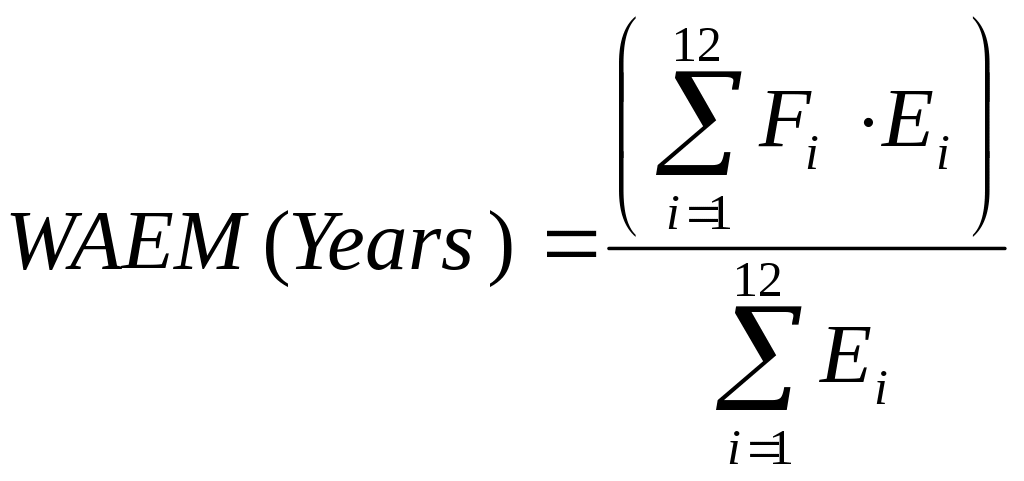
where Fi and Ei are the weighted average effective maturity (years) and EAD ($) reported in columns F and E, respectively, for the ith PD range in item numbers 1 through 12 of this schedule.
In column G, the EAD-weighted average LGD before consideration of eligible guarantees and credit derivatives (WALGD_Pre) in percentage terms is calculated as follows:

where Gi and Ei are the weighted average LGD before consideration of eligible guarantees and credit derivatives (%) and EAD ($) reported in columns G and E, respectively, for the ith PD range in item numbers 1 through 12 of this schedule.
In column H, the EAD-weighted average LGD after consideration of consideration of credit risk mitigants (WALGD_Post) in percentage terms is calculated as follows:

where Hi and Ei are the LGD after consideration of credit risk mitigants (%) and EAD ($) reported in columns H and E, respectively, for the ith PD range in item numbers 1 through 12 of this schedule.
In columns B, C, D, E, I, J, K, and L, the sums are calculated as the total of amounts reported in item numbers 1 through 12 of this schedule for each of these respective columns.
14 Report the risk weighted assets of non-material portfolios reportable in this schedule, but not included in the cells above.
Schedule D – Wholesale Exposures - Bank
Report all Wholesale Exposures - Bank. For this schedule, Bank includes the following entities: (1) banks and depository institutions as defined in the Glossary of the Reports of Condition and Income under the following headings: Banks, U.S. and Foreign; and Depository Institutions in the U.S.; (2) securities firms; and (3) multi-lateral development banks that do not have full faith and credit backing of sovereign entities.
Item No. Instructions
1-12 In column A, report the weighted average obligor PD of exposures categorized as wholesale bank where the obligor PD falls within the indicated PD range. Cell A-12 equals 100.
In column B, report the total number of obligors included in this row for column A.
In column C, report the total balance sheet amount of exposures included in this row for column A.
In column D, report the total dollar value of available but undrawn balance of exposures included in this row for column A.
In column E, report the total EAD of exposures included in this row for column A.
In column F, report the weighted average M in years of exposures included in this row for column A.
In column G, report the weighted average LGD of exposures included in this row for column A. In estimating LGD, include the effects of collateral but not the effects of guarantees or credit derivatives.
In column H, report the weighted average LGD of exposures included in this row for column A. In estimating LGD, include the effects of credit risk mitigants (guarantees, credit derivatives, and collateral).
In column I, report the estimated benefit arising from the application of the PD substitution approach or the LGD adjustment approach to exposures included in this row, expressed in terms of a reduction in risk-weighted assets in dollars but only in cases where risk is mitigated through the use of eligible credit derivatives. The estimate can be derived by deducting the amount in column J of this row from the aggregated risk-weighted assets that would have resulted from the application of the IRB Wholesale risk-weight formula to all underlying obligations contained in this row if the PD Substitution approach and LGD Adjustment approach had not been applied. No estimate is required in cases where risk is mitigated through the use of eligible guarantees.
In column J, report the total risk weighted assets associated with all exposures included in this row for column A - after any credit risk mitigation adjustments.
In column K, report the dollar amount of ECL for exposures included in this row for column A.
13 In column A, the EAD-weighted average PD (WAPD) in percentage terms is calculated as follows:
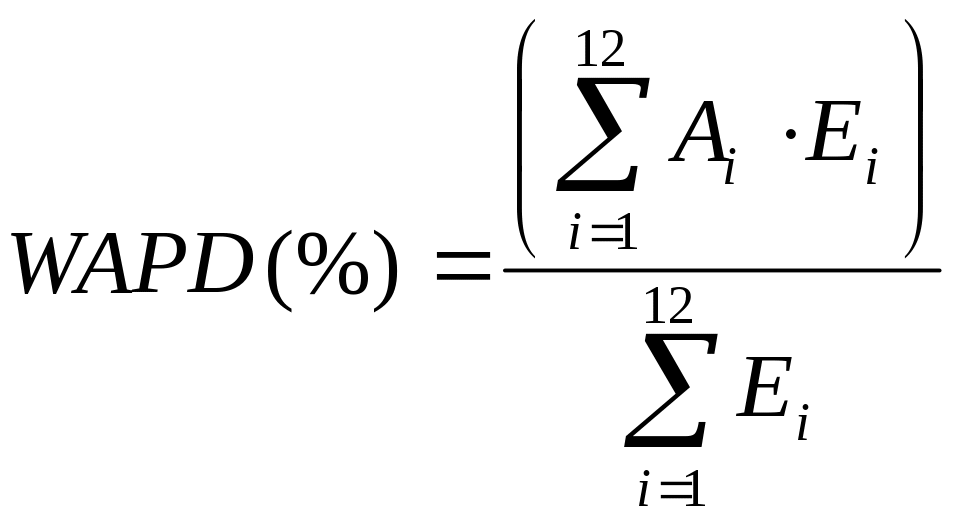
where Ai and Ei are the weighted average PD (%) and EAD ($) reported in columns A and E, respectively, for the ith PD range in item numbers 1 through 12 of this schedule. Note that A12 equals 100.
In column F, the EAD-weighted average effective maturity (WAEM) in years is calculated as follows:
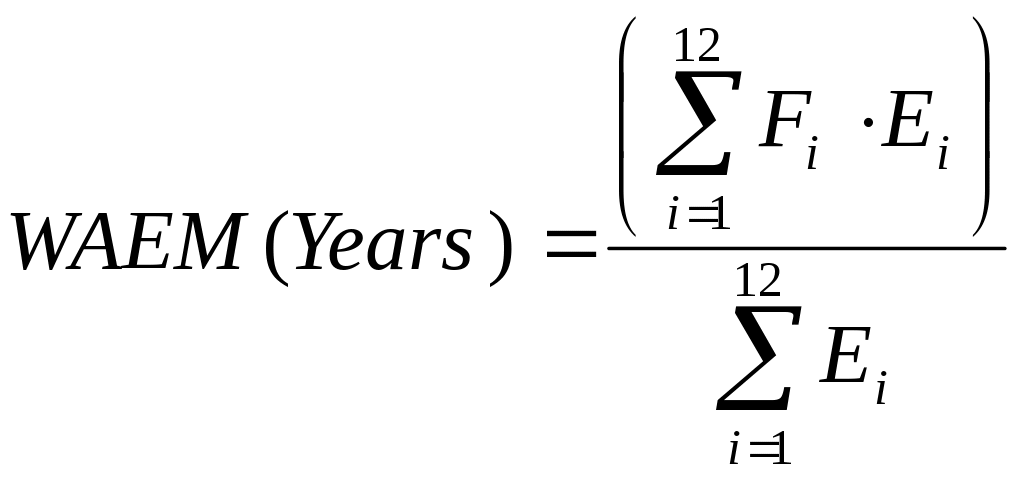
where Fi and Ei are the weighted average effective maturity (years) and EAD ($) reported in columns F and E, respectively, for the ith PD range in item numbers 1 through 12 of this schedule.
In column G, the EAD-weighted average LGD before consideration of eligible guarantees and credit derivatives (WALGD_Pre) in percentage terms is calculated as follows:

where Gi and Ei are the weighted average LGD before consideration of eligible guarantees and credit derivatives (%) and EAD ($) reported in columns G and E, respectively, for the ith PD range in item numbers 1 through 12 of this schedule.
In column H, the EAD-weighted average LGD after consideration of consideration of credit risk mitigants (WALGD_Post) in percentage terms is calculated as follows:

where Hi and Ei are the LGD after consideration of credit risk mitigants (%) and EAD ($) reported in columns H and E, respectively, for the ith PD range in item numbers 1 through 12 of this schedule.
In columns B, C, D, E, I, J, and K, the sums are calculated as the total of amounts reported in item numbers 1 through 12 of this schedule for each of these respective columns.
14 Report the risk weighted assets of non-material portfolios reportable in this schedule, but not included in the cells above.
Schedule E – Wholesale Exposures - Sovereign
Report all Wholesale Exposures – Sovereign (Sovereign exposures)
Item No. Instructions
1-12 In column A, report the weighted average obligor PD of exposures categorized as wholesale sovereign where the obligor PD falls within the indicated PD range. Cell A-12 equals 100.
In column B, report the total number of obligors included in this row for column A.
In column C, report the total balance sheet amount of exposures included in this row for column A.
In column D, report the total dollar value of available but undrawn balance of exposures included in this row for column A.
In column E, report the total EAD of exposures included in this row for column A.
In column F, report the weighted average M in years of exposures included in this row for column A.
In column G, report the weighted average LGD of exposures included in this row for column A. In estimating LGD, include the effects of collateral but not the effects of guarantees or credit derivatives.
In column H, report the weighted average LGD of exposures included in this row for column A. In estimating LGD, include the effects of credit risk mitigants (guarantees, credit derivatives, and collateral).
In column I, report the estimated benefit arising from the application of the PD substitution approach or the LGD adjustment approach to exposures included in this row, expressed in terms of a reduction in risk-weighted assets in dollars but only in cases where risk is mitigated through the use of eligible credit derivatives. The estimate can be derived by deducting the amount in column J of this row from the aggregated risk-weighted assets that would have resulted from the application of the IRB Wholesale risk-weight formula to all underlying obligations contained in this row if the PD Substitution approach and LGD Adjustment approach had not been applied. No estimate is required in cases where risk is mitigated through the use of eligible guarantees.
In column J, report the total risk weighted assets associated with all exposures included in this row for column A - after any credit risk mitigation adjustments.
In column K, report the dollar amount of ECL for exposures included in this row for column A.
13 In column A, the EAD-weighted average PD (WAPD) in percentage terms is calculated as follows:
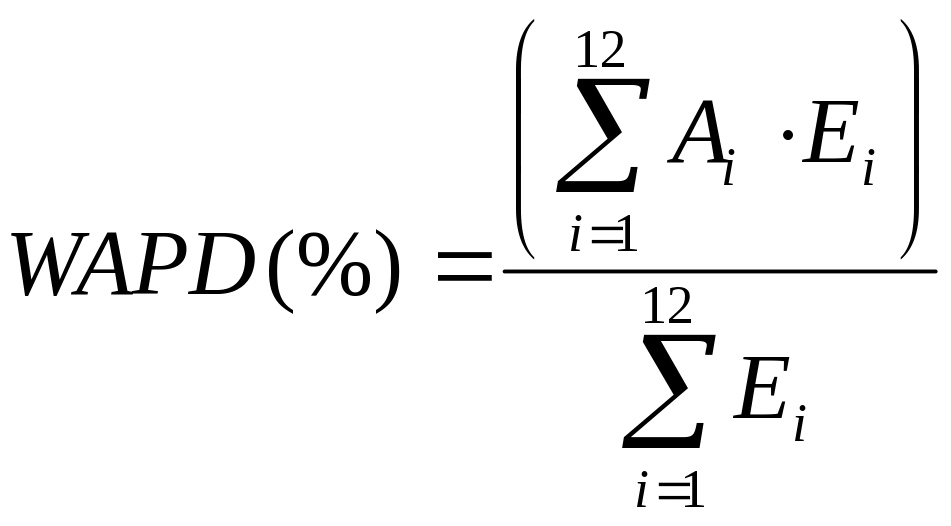
where Ai and Ei are the weighted average PD (%) and EAD ($) reported in columns A and E, respectively, for the ith PD range in item numbers 1 through 12 of this schedule. Note that A12 equals 100.
In column F, the EAD-weighted average effective maturity (WAEM) in years is calculated as follows:
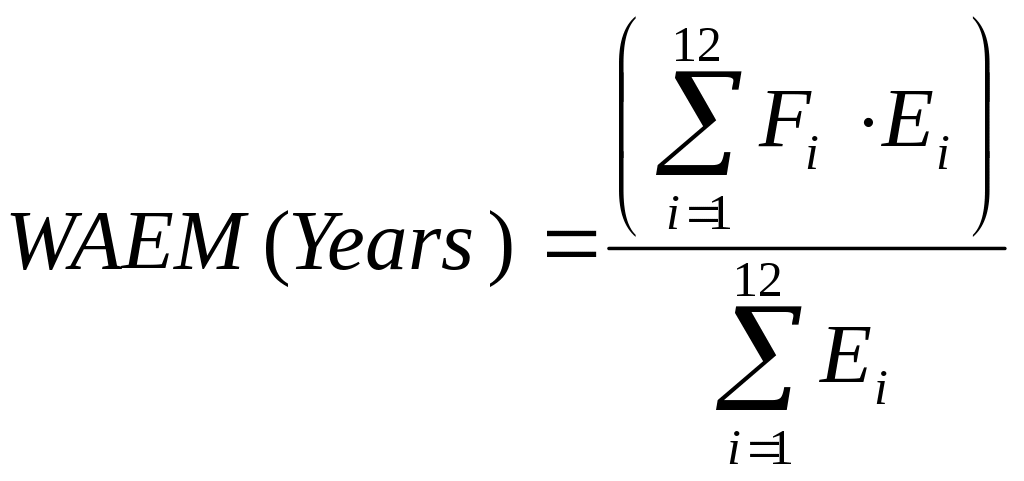
where Fi and Ei are the weighted average effective maturity (years) and EAD ($) reported in columns F and E, respectively, for the ith PD range in item numbers 1 through 12 of this schedule.
In column G, the EAD-weighted average LGD before consideration of eligible guarantees and credit derivatives (WALGD_Pre) in percentage terms is calculated as follows:

where Gi and Ei are the weighted average LGD before consideration of eligible guarantees and credit derivatives (%) and EAD ($) reported in columns G and E, respectively, for the ith PD range in item numbers 1 through 12 of this schedule.
In column H, the EAD-weighted average LGD after consideration of consideration of credit risk mitigants (WALGD_Post) in percentage terms is calculated as follows:

where Hi and Ei are the LGD after consideration of credit risk mitigants (%) and EAD ($) reported in columns H and E, respectively, for the ith PD range in item numbers 1 through 12 of this schedule.
In columns B, C, D, E, I, J, and K, the sums are calculated as the total of amounts reported in item numbers 1 through 12 of this schedule for each of these respective columns.
14 Report the risk weighted assets of non-material portfolios reportable in this schedule, but not included in the cells above.
Schedule F – Wholesale Exposures – Income-Producing Real Estate (IPRE)
IPRE includes exposures that finance the acquisition, development, or construction (ADC) of one-to-four family residential properties, or commercial real estate projects that are not defined as HVCRE as well as permanent financing of commercial real estate and apartment buildings.
Item No. Instructions
1-12 In column A, report the weighted average obligor PD of exposures categorized as wholesale IPRE where the obligor PD falls within the indicated PD range. Cell A-12 equals 100.
In column B, report the total number of obligors included in this row for column A.
In column C, report the total balance sheet amount of exposures included in this row for column A.
In column D, report the total dollar value of available but undrawn balance of exposures included in this row for column A.
In column E, report the total EAD of exposures included in this row for column A.
In column F, report the weighted average M in years of exposures included in this row for column A.
In column G, report the weighted average LGD of exposures included in this row for column A. In estimating LGD, include the effects of collateral but not the effects of guarantees or credit derivatives.
In column H, report the weighted average LGD of exposures included in this row for column A. In estimating LGD, include the effects of credit risk mitigants (guarantees, credit derivatives and collateral).
In column I, report the estimated benefit arising from the application of the PD substitution approach or the LGD adjustment approach to exposures included in this row, expressed in terms of a reduction in risk-weighted assets in dollars but only in cases where risk is mitigated through the use of eligible credit derivatives. The estimate can be derived by deducting the amount in column K of this row from the aggregated risk-weighted assets that would have resulted from the application of the IRB Wholesale risk-weight formula to all underlying obligations contained in this row if the PD Substitution approach and LGD Adjustment approach had not been applied. No estimate is required in cases where risk is mitigated through the use of eligible guarantees.
In column J, report the estimated benefit arising from the application of the double default treatment to exposures included in this row, expressed in terms of a reduction in risk-weighted assets in dollars. The estimate can be derived by deducting the amount in column K of this row from the aggregated risk-weighted assets that would have resulted from the application of the IRB Wholesale risk-weight formula to all underlying obligations contained in this row as if double default treatment had not been applied. The estimate should reflect only credit risk mitigation benefits derived from the application of the double default treatment.
In column K, report the total risk weighted assets associated with all exposures included in this row for column A - after any credit risk mitigation adjustments including application of double default treatment.
In column L, report the dollar amount of ECL for exposures included in this row for column A.
13 In column A, the EAD-weighted average PD (WAPD) in percentage terms is calculated as follows:
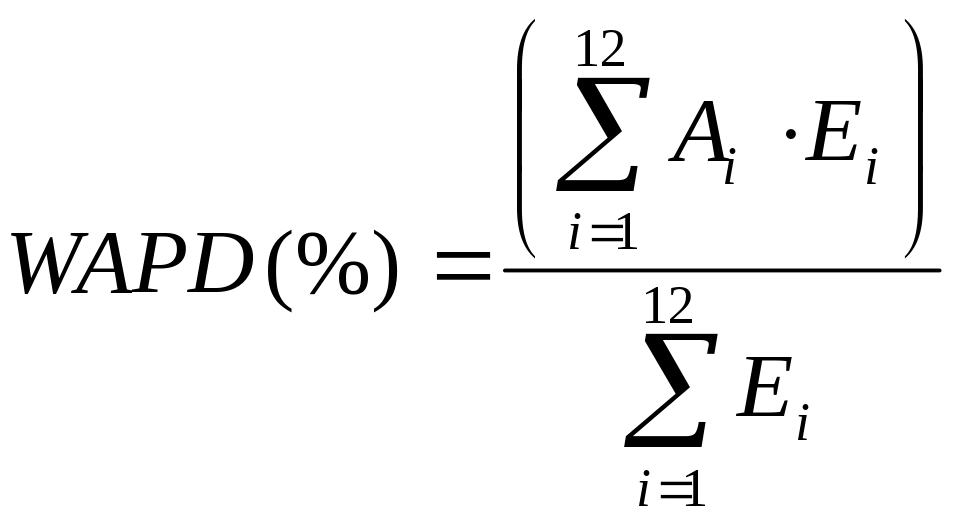
where Ai and Ei are the weighted average PD (%) and EAD ($) reported in columns A and E, respectively, for the ith PD range in item numbers 1 through 12 of this schedule. Note that A12 equals 100.
In column F, the EAD-weighted average effective maturity (WAEM) in years is calculated as follows:

where Fi and Ei are the weighted average effective maturity (years) and EAD ($) reported in columns F and E, respectively, for the ith PD range in item numbers 1 through 12 of this schedule.
In column G, the EAD-weighted average LGD before consideration of eligible guarantees and credit derivatives (WALGD_Pre) in percentage terms calculated as follows:

where Gi and Ei are the weighted average LGD before consideration of eligible guarantees and credit derivatives (%) and EAD ($) reported in columns G and E, respectively, for the ith PD range in item numbers 1 through 12 of this schedule.
In column H, the EAD-weighted average LGD after consideration of consideration of credit risk mitigants (WALGD_Post) in percentage terms is calculated as follows:

where Hi and Ei are the LGD after consideration of credit risk mitigants (%) and EAD ($) reported in columns H and E, respectively, for the ith PD range in item numbers 1 through 12 of this schedule.
In columns B, C, D, E, I, J, K, and L, the sums are calculated as the total of amounts reported in item numbers 1 through 12 of this schedule for each of these respective columns.
14 Report the risk weighted assets of non-material portfolios reportable in this schedule, but not included in the cells above.
Schedule G – Wholesale Exposures – High Volatility Commercial Real Estate (HVCRE)
Report all Wholesale Exposures – High Volatility Commercial Real Estate (HVCRE)
Item No. Instructions
1-12 In column A, report the weighted average obligor PD of exposures categorized as wholesale HVCRE where the obligor PD falls within the indicated PD range. Cell A-12 equals 100.
In column B, report the total number of obligors included in this row for column A.
In column C, report the total balance sheet amount of exposures included in this row for column A.
In column D, report the total dollar value of available but undrawn balance of exposures included in this row for column A.
In column E, report the total EAD of exposures included in this row for column A.
In column F, report the weighted average M in years of exposures included in this row for column A.
In column G, report the weighted average LGD of exposures included in this row for column A. In estimating LGD, include the effects of collateral but not the effects of guarantees or credit derivatives.
In column H, report the weighted average LGD of exposures included in this row for column A. In estimating LGD, include the effects of credit risk mitigants (guarantees, credit derivatives and collateral).
In column I, report the estimated benefit arising from the application of the PD substitution approach or the LGD adjustment approach to exposures included in this row, expressed in terms of a reduction in risk-weighted assets in dollars but only in cases where risk is mitigated through the use of eligible credit derivatives. The estimate can be derived by deducting the amount in column K of this row from the aggregated risk-weighted assets that would have resulted from the application of the IRB Wholesale risk-weight formula to all underlying obligations contained in this row if the PD Substitution approach and LGD Adjustment approach had not been applied. No estimate is required in cases where risk is mitigated through the use of eligible guarantees.
In column J, report the estimated benefit arising from the application of the double default treatment to exposures included in this row, expressed in terms of a reduction in risk-weighted assets in dollars. The estimate can be derived by deducting the amount in column K of this row from the aggregated risk-weighted assets that would have resulted from the application of the IRB Wholesale risk-weight formula to all underlying obligations contained in this row as if double default treatment had not been applied.
The estimate should reflect only credit risk mitigation benefits derived from the application of the double default treatment.
In column K, report the total risk weighted assets associated with all exposures included in this row for column A - after any credit risk mitigation adjustments including application of double default treatment.
In column L, report the dollar amount of ECL for exposures included in this row for column A.
13 In column A, the EAD-weighted average PD (WAPD) in percentage terms is calculated as follows:
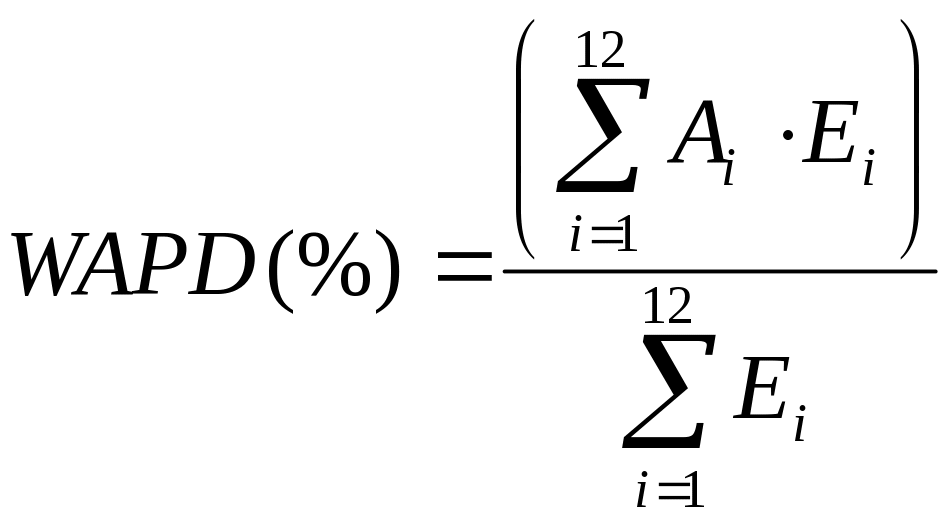
where Ai and Ei are the weighted average PD (%) and EAD ($) reported in columns A and E, respectively, for the ith PD range in item numbers 1 through 12 of this schedule. Note that A12 equals 100.
In column F, the EAD-weighted average effective maturity (WAEM) in years is calculated as follows:

where Fi and Ei are the weighted average effective maturity (years) and EAD ($) reported in columns F and E, respectively, for the ith PD range in item numbers 1 through 12 of this schedule.
In column G, the EAD-weighted average LGD before consideration of eligible guarantees and credit derivatives (WALGD_Pre) in percentage terms is calculated as follows:

where Gi and Ei are the weighted average LGD before consideration of eligible guarantees and credit derivatives (%) and EAD ($) reported in columns G and E, respectively, for the ith PD range in item numbers 1 through 12 of this schedule.
In column H, the EAD-weighted average LGD after consideration of consideration of credit risk mitigants (WALGD_Post) in percentage terms is calculated as follows:

where Hi and Ei are the LGD after consideration of credit risk mitigants (%) and EAD ($) reported in columns H and E, respectively, for the ith PD range in item numbers 1 through 12 of this schedule.
In columns B, C, D, E, I, J, K, and L, the sums are calculated as the total of amounts reported in item numbers 1 through 12 of this schedule for each of these respective columns.
14 Report the risk weighted assets of non-material portfolios reportable in this schedule, but not included in the cells above.
Schedules H through J – Wholesale Exposures - Eligible Margin Loans, Repo-Style Transactions, OTC Derivatives, and Combinations of these Instruments Subject to Qualifying Master Netting Agreements
General Instructions
Definitions. Apply the definitions provided in the final rule for the following terms: (1) probability of default (PD); (2) loss given default (LGD); (3) exposure at default (EAD); (4) effective maturity (M); (5) expected credit loss (ECL); (6) qualifying cross-product master netting agreement; (7) eligible margin loan; (8) obligor; (9) OTC derivative contract; (10) qualifying master netting agreement; (11) repo-style transaction; (12) Value-at-Risk (VaR); (13) wholesale exposure; and (14) default.
The EAD adjustment approaches are described in section 32(b)(2), section 32(b)(3), and section 32(d) of the final rule.
For these schedules, report all repo-style transactions, eligible margin loans, and OTC derivatives, including those that are covered positions under the market risk rule, except for credit derivatives and equity derivative contracts for which the bank does not compute a separate counterparty credit risk capital requirement in accordance with sections 32(c)(3) and (4) of the final rule.
Weighted Averages. Weighted average obligor PD as used in this section is calculated by: (1) determining the obligors and their exposures that fall within each of the PD ranges indicated, (2) multiplying each obligor’s PD by its total EAD, (3) summing the products from step (2) for all exposures within each PD range, and (4) dividing the summed products from step (3) by the sum of the EADs of all exposures in the same PD range.
Weighted average LGD as used in this section is calculated by: (1) determining the obligors and their exposures that have estimated PDs that fall within each of the PD ranges indicated, (2) multiplying each exposure’s LGD by its EAD, (3) summing the products from step (2) for all exposures within each PD range, and (4) dividing the summed products from step (3) by the sum of the EADs of all exposures in the same PD range.
Weighted average M as used in this section is calculated by: (1) determining the obligors and their exposures that have estimated PDs prior to considering the effects of credit risk mitigation that fall within each of the PD ranges indicated, (2) multiplying each exposure’s estimated M by its EAD, (3) summing the products from step (2) for all exposures within each PD range, and (4) dividing the summed products from step (3) by the sum of the EADs of all exposures in the same PD range.
Schedule H – Wholesale Exposures – Eligible Margin Loans, Repo-style Transactions, and OTC Derivatives with Cross-Product Netting
Report all eligible margin loans, repo-style transactions and OTC derivatives positions that are subject to a qualifying cross-product master netting agreement. Exposures that are not covered by qualifying cross-product master netting agreements are reported separately in Schedules I and J.
Exposures Where the EAD Adjustment Method is Used
Item No. Instructions
1-12 In column A, report the weighted average obligor PD of all eligible margin loans, repo-style transactions, and OTC derivatives covered by qualified cross-product master netting agreements where the obligor PD falls within each PD range indicated. Cell A-12 equals 100.
In column B, report the weighted average M in years of exposures included in this row for column A.
In column C, report the total EAD of exposures included in this row for column A.
In column D, report the weighted average LGD of exposures included in this row for column A.
In column E, report the total risk weighted assets associated with all exposures included in this row for column A.
In column F, report the ECL associated with the exposures aggregated in this row for column A.
13 In column C, report the EAD of eligible margin loans where a 300 percent risk weight has been assigned.
In column E, report the risk weighted assets of eligible margin loans where a 300 percent risk weight has been assigned.
14 In column A, the EAD-weighted average PD (WAPD) in percentage terms is calculated as follows:

where Ai and Ci are the weighted average PD (%) and EAD ($) reported in columns A and C, respectively, for the ith PD range in item numbers 1 through 12 of this schedule. Note that A12 equals 100.
In column B, the EAD-weighted average effective maturity (WAEM) in years is calculated as follows:
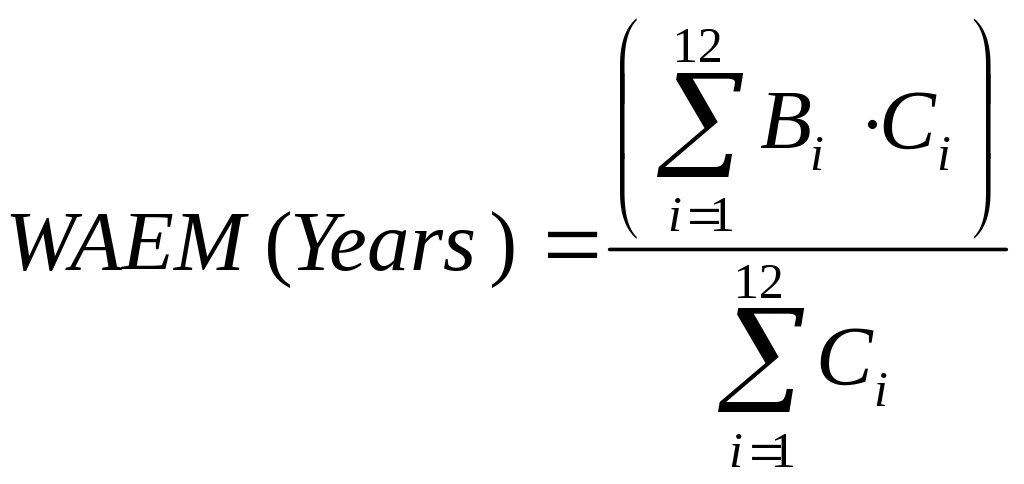
where Bi and Ci are the weighted average effective maturity (years) and EAD ($) reported in columns B and C, respectively, for the ith PD range in item numbers 1 through 12 of this schedule.
In column D, the percent EAD-weighted average LGD (WALGD) in percentage terms is calculated as follows:

where Di and Ci are the weighted average LGD (%) and EAD ($) reported in columns D and C, respectively, for the ith PD range in item numbers 1 through 12 of this schedule.
In columns C and E, the sums are calculated as the total of amounts reported in item numbers 1 through 13 of this schedule for each of these respective columns.
In column F, the sum is calculated as the total of amounts reported in item numbers 1 through 12 of this schedule for column F.
Exposures Where Collateral is Reflected in LGD
In column G, report the weighted average obligor PD of all eligible margin loans, repo-style transactions, and OTC derivatives covered by qualified cross-product master netting agreements where the obligor PD falls within each PD range indicated. Cell G-12 equals 100.
In column H, report the weighted average M in years of exposures included in this row for column G.
In column I, report the total EAD of exposures included in this row for column G.
In column J, report the weighted average LGD of exposures included in this row for column G.
In column K, report the total risk weighted assets associated with all exposures included in this row for column G.
In column L, report the ECL associated with the exposures aggregated in this row for column G.
14 In column G, the EAD-weighted average PD (WAPD) in percentage terms is calculated as follows:
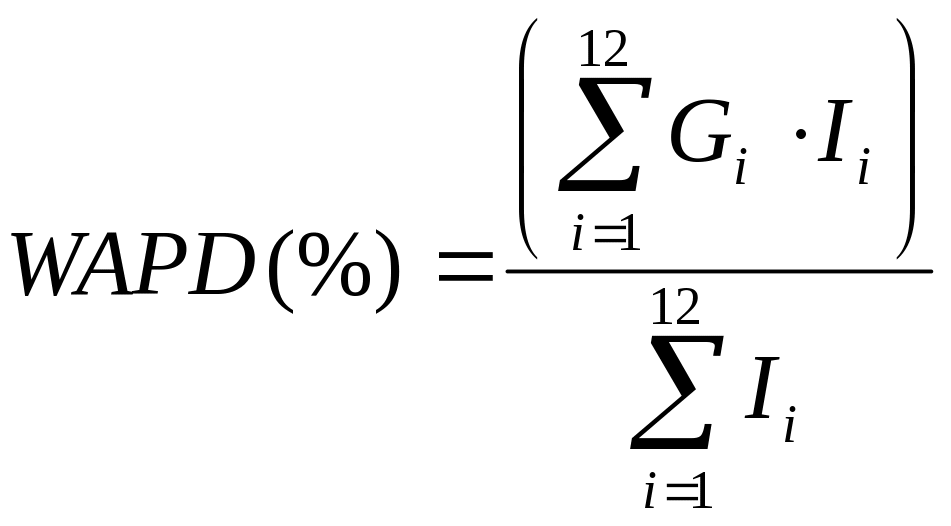
where Gi and Ii are the weighted average PD (%) and EAD ($) reported in columns G and I, respectively, for the ith PD range in item numbers 1 through 12 of this schedule. Note that G12 equals 100.
In column H, the EAD-weighted average effective maturity (WAEM) in years is calculated as follows:
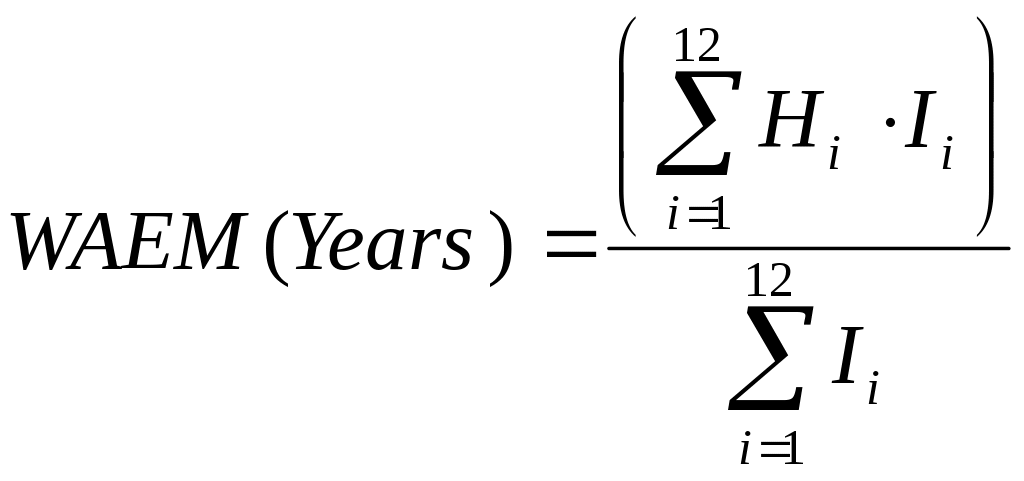
where Hi and Ii are the weighted average effective maturity (years) and EAD ($) reported in columns H and I, respectively, for the ith PD range in item numbers 1 through 12 of this schedule.
In column J, the EAD-weighted average LGD (WALGD) in percentage terms is calculated as follows:
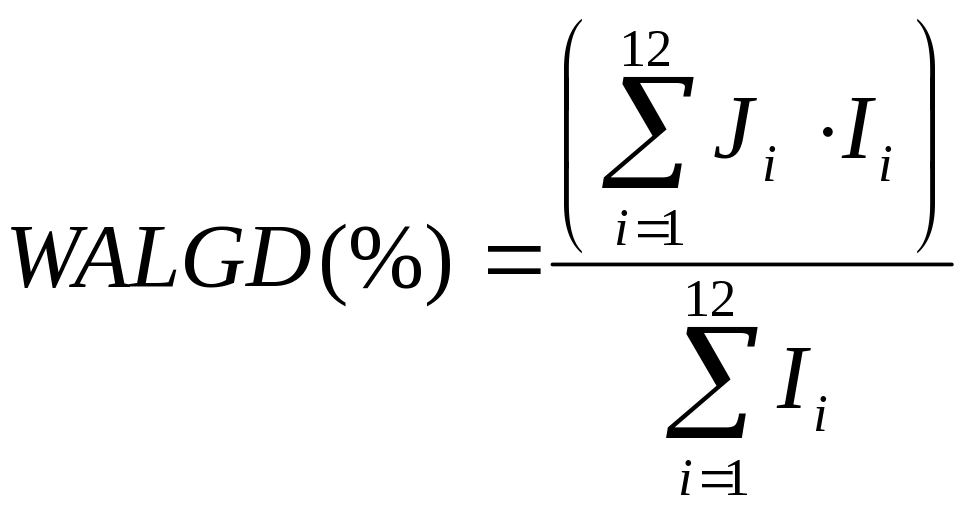
where Ji and Ii are the weighted average LGD (%) and EAD ($) reported in columns J and I, respectively, for the ith PD range in item numbers 1 through 12 of this schedule.
In columns I, K, and L, the sums are calculated as the total of amounts reported in item numbers 1 through 12 of this schedule for each of these respective columns.
Schedule I – Wholesale Exposures – Eligible Margin Loans and Repo-style Transactions with No Cross-Product Netting
Report all eligible margin loans and repo-style transactions that are NOT subject to a qualifying cross-product master netting agreement.
Exposures Where the EAD Adjustment Method is Used
Item No. Instructions
1-12 In column A, report the weighted average obligor PD of all eligible margin loans and repo-style transactions not covered by qualified cross-product master netting agreements where the obligor PD falls within each PD range indicated. Cell A-12 equals 100.
In column B, report the weighted average M in years of exposures included in this row for column A.
In column C, report the total EAD of exposures included in this row for column A.
In column D, report the weighted average LGD of exposures included in this row for column A.
In column E, report the total risk weighted assets associated with all exposures included in this row for column A.
In column F, report the ECL associated with the exposures aggregated in this row for column A.
13 In column C, report the EAD of eligible margin loans where a 300 percent risk weight has been assigned.
In column E, report the risk weighted assets of eligible margin loans where a 300 percent risk weight has been assigned.
14 In column A, the EAD-weighted average PD (WAPD) in percentage terms is calculated as follows:
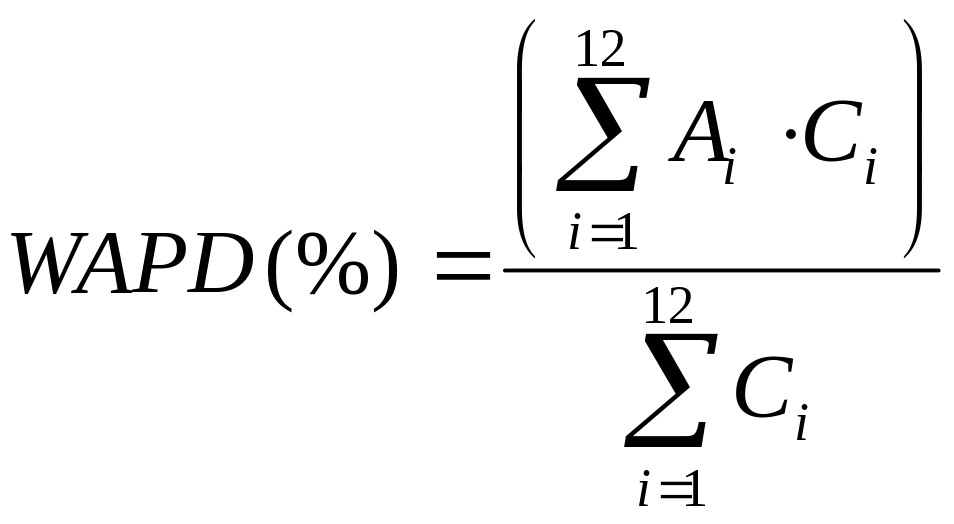
where Ai and Ci are the weighted average PD (%) and EAD ($) reported in columns A and C, respectively, for the ith PD range in item numbers 1 through 12 of this schedule. Note that A12 equals 100.
In column B, the EAD-weighted average effective maturity (WAEM) in years is calculated as follows:
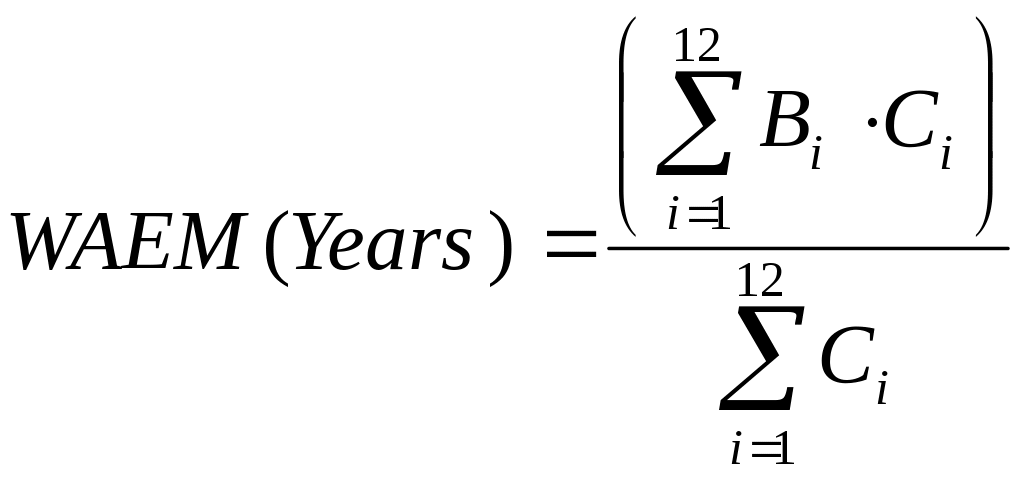
where Bi and Ci are the weighted average effective maturity (years) and EAD ($) reported in columns B and C, respectively, for the ith PD range in item numbers 1 through 12 of this schedule.
In column D, the EAD-weighted average LGD (WALGD) in percentage terms is calculated as follows:
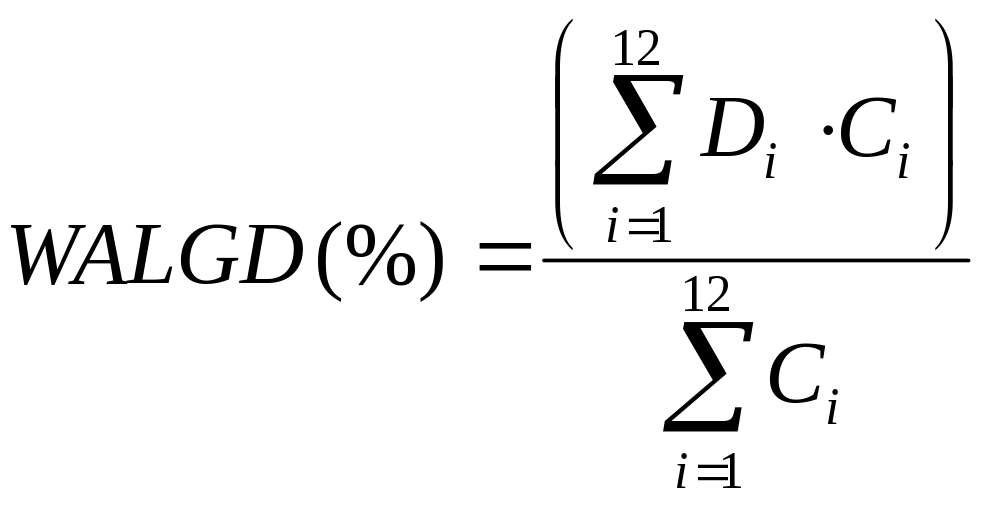
where Di and Ci are the weighted average LGD (%) and EAD ($) reported in columns D and C, respectively, for the ith PD range in item numbers 1 through 12 of this schedule.
In columns C and E, the sums are calculated as the total of amounts reported in item numbers 1 through 13 of this schedule for each of these respective columns.
In column F, the sum is calculated as the total of amounts reported in item numbers 1 through 12 of this schedule for column F.
Exposures Where Collateral is Reflected in LGD
1-12 In column G, report the weighted average obligor PD of all eligible margin loans and repo-style transactions not covered by qualified cross-product master netting agreements where the obligor PD falls within each PD range indicated. Cell G-12 equals 100.
In column H, report the weighted average M in years of exposures included in this row for column G.
In column I, report the total EAD of exposures included in this row for column G.
In column J, report the weighted average LGD of exposures included in this row for column G.
In column K, report the total risk weighted assets associated with all exposures included in this row for column G.
In column L, report the ECL associated with the exposures aggregated in this row for column G.
14 In column G, the EAD-weighted average PD (WAPD) in percentage terms is calculated as follows:
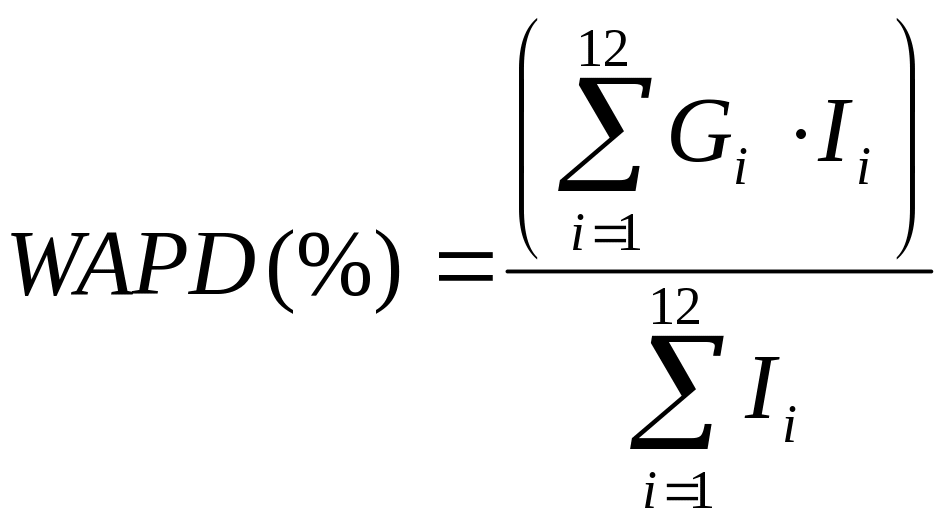
where Gi and Ii are the weighted average PD (%) and EAD ($) reported in columns G and I, respectively, for the ith PD range in item numbers 1 through 12 of this schedule. Note that G12 equals 100.
In column H, the EAD-weighted average effective maturity (WAEM) in years is calculated as follows:
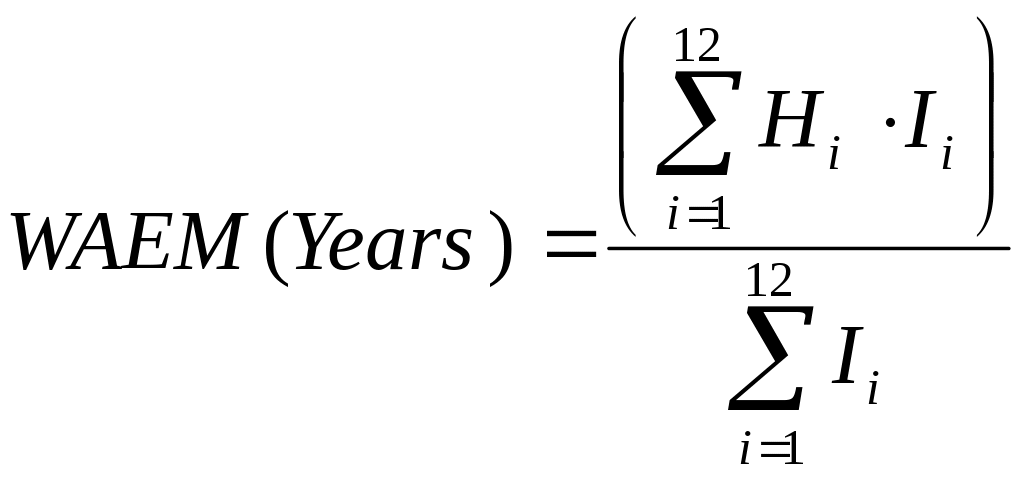
where Hi and Ii are the weighted average effective maturity (years) and EAD ($) reported in columns H and I, respectively, for the ith PD range in item numbers 1 through 12 of this schedule.
In column J, the EAD-weighted average LGD (WALGD) in percentage terms is calculated as follows:

where Ji and Ii are the weighted average LGD (%) and EAD ($) reported in columns J and I, respectively, for the ith PD range in item numbers 1 through 12 of this schedule.
In columns I, K, and L, the sums are calculated as the total of amounts reported in item numbers 1 through 12 of this schedule for each of these respective columns.
Memoranda Items
M1 Report the percentage, to one decimal place, of total EAD for this schedule (item 14, column C) calculated using collateral haircuts.
M2 Report the percentage, to one decimal place, of total EAD for this schedule (item 14, column C) calculated using simple VaR.
M3 Report the percentage, to one decimal place, of total EAD for this schedule (item 14, column C) calculated using internal models.
Schedule J – Wholesale Exposures – OTC Derivatives with No Cross-Product Netting
Report all OTC derivative positions which are NOT subject to a qualifying cross-product master netting agreement.
Exposures Where the EAD Adjustment Method is Used
Item No. Instructions
1-12 In column A, report the weighted average obligor PD of all OTC derivatives transactions not covered by qualified cross-product master netting agreements where the obligor PD falls within each PD range indicated. Cell A-12 equals 100.
In column B, report the weighted average M in years of exposures included in this row for column A.
In column C, report the total EAD of exposures included in this row for column A.
In column D, report the weighted average LGD of exposures included in this row for column A.
In column E, report the total risk weighted assets associated with all exposures included in this row for column A.
In column F, report the ECL associated with the exposures aggregated in this row for column A.
13 In column A, the EAD-weighted average PD (WAPD) in percentage terms is calculated as follows:
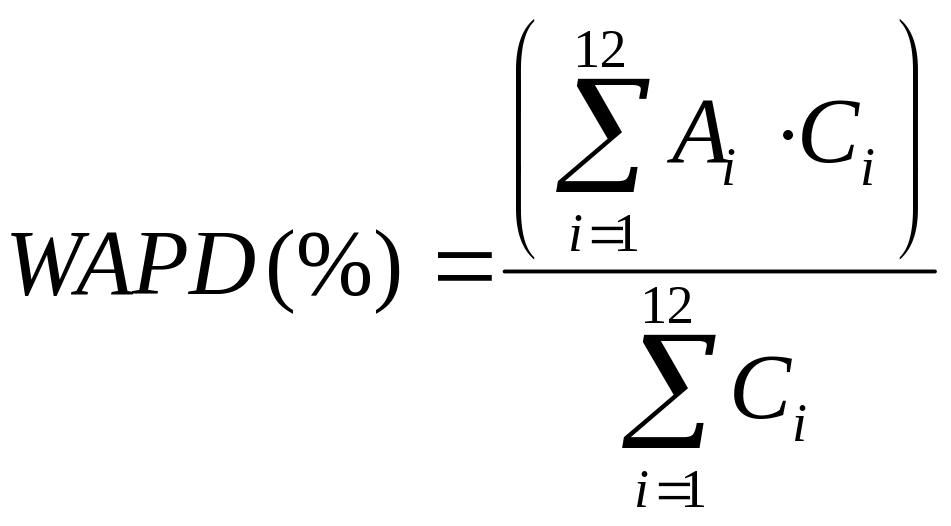
where Ai and Ci are the weighted average PD (%) and EAD ($) reported in columns A and C, respectively, for the ith PD range in item numbers 1 through 12 of this schedule. Note that A12 equals 100.
In column B, the EAD-weighted average effective maturity (WAEM) in years is calculated as follows:
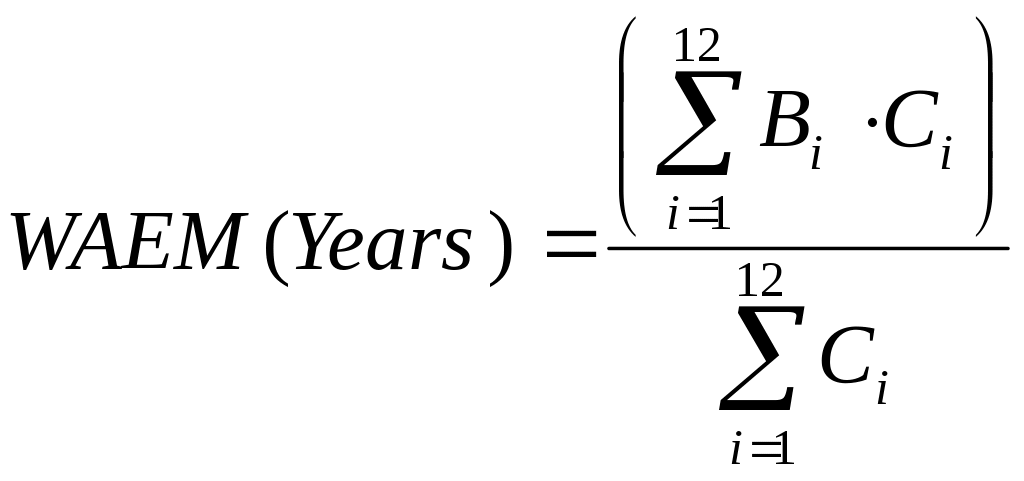
where Bi and Ci are the weighted average effective maturity (years) and EAD ($) reported in columns B and C, respectively, for the ith PD range in item numbers 1 through 12 of this schedule.
In column D, the EAD-weighted average LGD (WALGD) in percentage terms is calculated as follows:
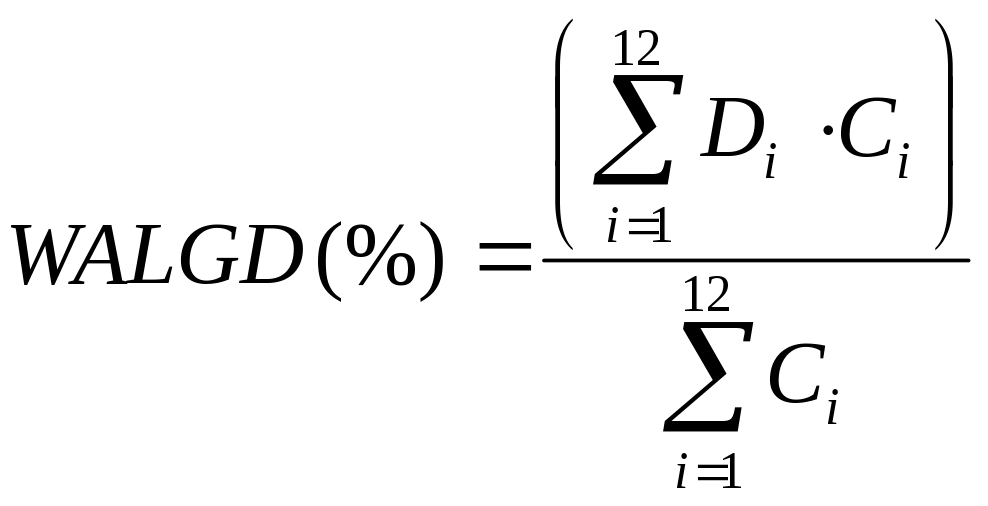
where Di and Ci are the weighted average LGD (%) and EAD ($) reported in columns D and C, respectively, for the ith PD range in item numbers 1 through 12 of this schedule.
In columns C, E, and F, the sums are calculated as the total of amounts reported in item numbers 1 through 12 of this schedule for each of these respective columns.
Exposures For Which the Bank Uses the Current Exposure Methodology to Determine EAD and Reflects Collateral, if any, in LGD.
1-12 In column G, report the weighted average obligor PD of all OTC derivatives transactions not covered by qualified cross-product master netting agreements where the obligor PD falls within each PD range indicated. Cell G-12 equals 100.
In column H, report the weighted average M in years of exposures included in this row for column G.
In column I, report the total EAD of exposures included in this row for column G.
In column J, report the weighted average LGD of exposures included in this row for column G.
In column K, report the total risk weighted assets associated with all exposures included in this row for column G.
In column L, report the ECL associated with the exposures aggregated in this row for column G.
14 In column G, the EAD-weighted average PD (WAPD) in percentage terms is calculated as follows:
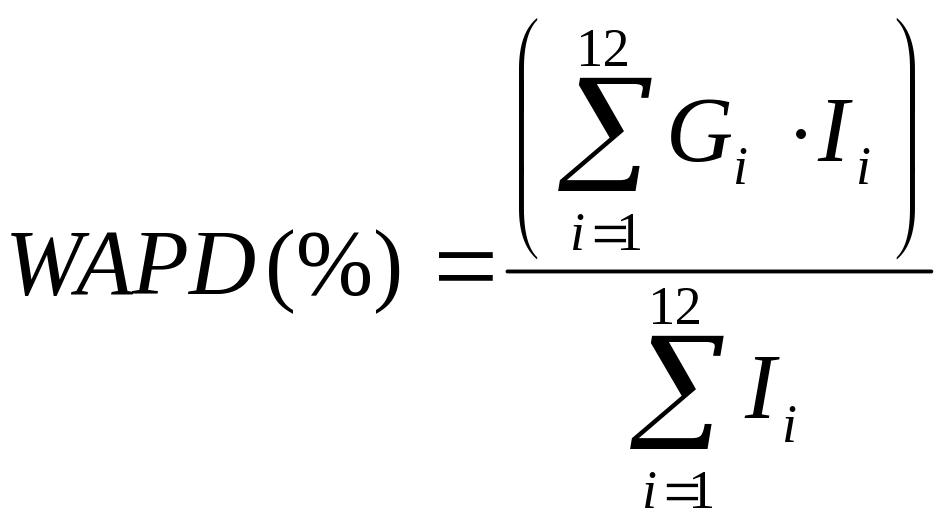
where Gi and Ii are the weighted average PD (%) and EAD ($) reported in columns G and I, respectively, for the ith PD range in item numbers 1 through 12 of this schedule. Note that G12 equals 100.
In column H, the EAD-weighted average effective maturity (WAEM) in years is calculated as follows:
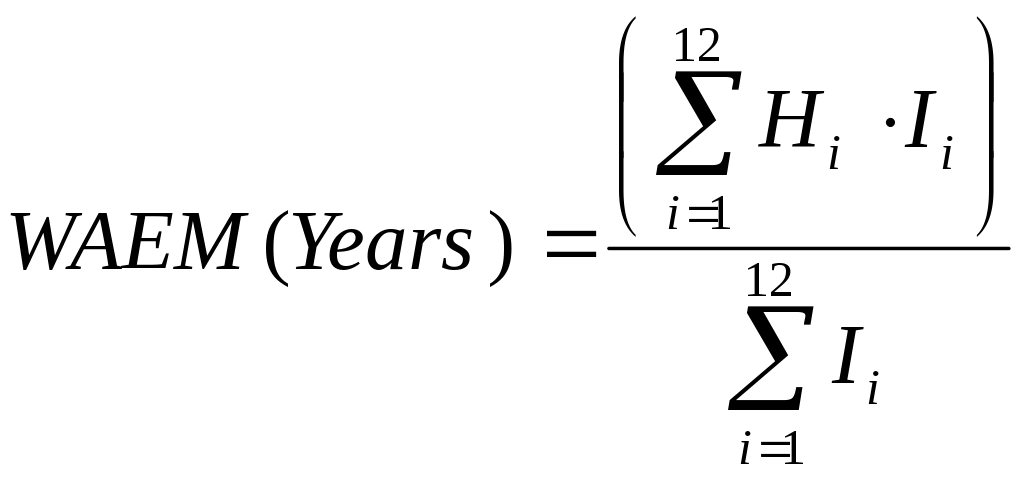
where Hi and Ii are the weighted average effective maturity (years) and EAD ($) reported in columns H and I, respectively, for the ith PD range in item numbers 1 through 12 of this schedule.
In column J, the EAD-weighted average LGD (WALGD) in percentage terms is calculated as follows:
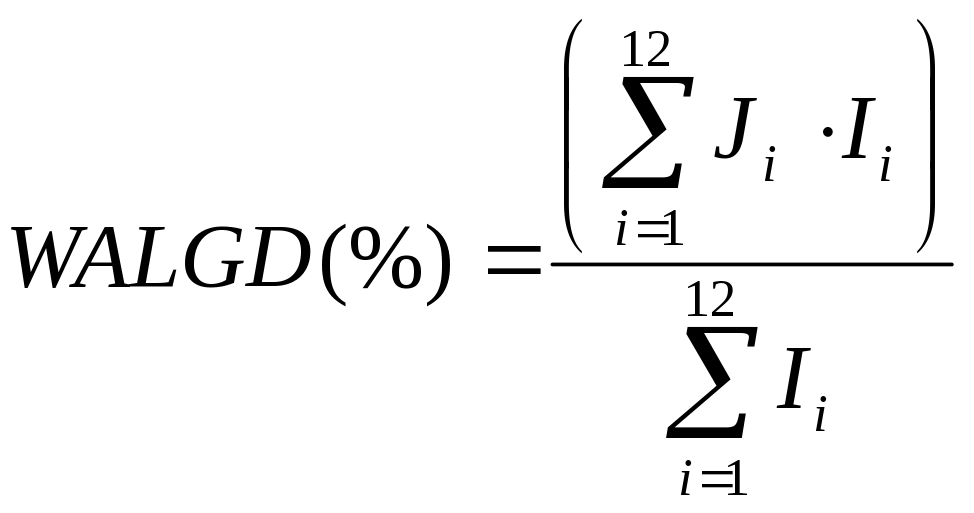
where Ji and Ii are the weighted average LGD (%) and EAD ($) reported in columns J and I, respectively, for the ith PD range in item numbers 1 through 12 of this schedule.
In columns I, K, and L, the sums are calculated as the total of amounts reported in item numbers 1 through 12 of this schedule for each of these respective columns.
Memoranda Items
M1 Report the percentage, to one decimal place, of total EAD for this schedule (item 13, column C) calculated using collateral haircuts.
M2 Report the percentage, to one decimal place, of total EAD for this schedule (item 13, column C) calculated using internal models.
Schedules K through O – Retail Exposures
General Instructions
These schedules should reflect summary or aggregate information based on the bank’s own segmentation system for risk-based capital purposes. For each retail category, banks should use the PDs calculated in its segmentation process as the basis for assigning exposures to rows that correspond to a specified supervisory PD band in each schedule.
Definitions. Apply the definitions provided in the final rule for the following terms: (1) probability of default (PD); (2) loss given default (LGD); (3) exposure at default (EAD); (4) expected credit loss (ECL);.(5) other retail exposure; (6) residential mortgage exposure; (7) default; (8) retail exposure; (9) credit risk mitigant; and (10) qualifying revolving exposure (QRE). Account age is described below.
Loan-to-Value. Loan-to–Value (LTV): Where LTV information is requested, reporting of these cells is required only if LTVs are available. If LTVs are used in the segmentation process, report the LTV that is used in the segmentation process. If LTVs are not used in the segmentation process, report the most recent well-supported LTV for the exposures (original or well supported updated LTV).
For closed-end first lien exposures, LTV ratios should be calculated with respect to only the bank’s first lien exposure amount. For closed-end junior liens and revolving mortgage exposures, LTV ratios should be calculated with respect to the bank’s junior lien exposures combined with any prior liens.
Credit Risk Score. Credit Risk Score: Reporting of these cells is required only if the scores are available. Report scores only from credit scoring systems with a common mapping from scores to default probabilities and/or expected losses. Where two or more credit scoring systems with different mappings are used in the same portfolio, report scores only from the system used for the largest number of exposures in that portfolio.
Weighted Averages. Weighted average PD as used in this section is calculated by: (1) determining the exposures that are in segments whose PDs fall within each of the PD ranges indicated, (2) multiplying each segment’s PD by its EAD, (3) summing the products from step (2) for all segments within each PD range, and (4) dividing the summed products from step (3) by the sum of the EADs of all segments in the same PD range.
Weighted average LGD as used in this section is calculated by: (1) determining the segments that have PDs that fall within each of the PD ranges indicated, (2) multiplying each segment’s LGD by its EAD, (3) summing the products from step (2) for all segments within each PD range, and (4) dividing the summed products from step (3) by the sum of the EADs of all segments in the same PD range.
Weighted average age as used in this section is calculated by: (1) determining the segments that have PDs that fall within each of the PD ranges indicated, (2) determining an average (or weighted average) age for each segment using the account age definitions described below, (3) multiplying each segment’s average age by its EAD, (4) summing the products from step (3) for all segments within each PD range, and (5) dividing the summed products from step (4) by the sum of EADs of all segments in the same PD range.
Weighted average credit scores are calculated in a similar manner as weighted average age. The difference is that the sum in the denominator only includes EADs of exposures in the exposure category that have a credit risk score available. Report weighted average credit scores for each of the PD ranges indicated to one decimal place.
Account Age. The following definitions should be used to determine the age of accounts: (i) for mortgage exposures and other types of closed-end loans, account age is defined as the number of months since origination; (ii) for qualifying revolving exposures, account age is defined as the number of months on the bank’s books; and (iii) for other retail exposures, account age should be determined using the number of months since whatever reference point the bank uses within its systems to identify the age of an account.
Schedule K – Retail Exposures – Residential Mortgage – Closed-end First Lien Exposures
Report all residential mortgage exposures that (1) are secured by first liens, and (2) are not revolving.
Item No. Instructions
1-15 In column A, report the weighted average PD of all segments of exposures applicable to this section as noted above, whose PD falls within each range indicated. Cell A-15 equals 100.
In column B, report the total number of exposures in all segments included in this row for column A.
In column C, report the total balance sheet amount of exposures within the segments included in this row for column A.
In column D, report the dollar volume of available but undrawn balances of exposures within the segments included in this row for column A. Include undrawn commitments to lend, including available negative amortization and unfunded mortgage commitments.
In column E, report the total EAD of segments of exposures included in this row for column A.
In column F, report the weighted average age in months of exposures in the segments included in this row for column A.
In column G, report the weighted average LGD of exposures in the segments included in this row for column A.
In column H, report total risk-weighted assets associated with all segments of exposures included in this row for column A.
In column I, report the dollar volume of ECL, after consideration of credit risk mitigation, for segments of exposures included in this row for column A.
In column J, report the EAD of exposures included in this row for column A that have less than a 70% LTV.
In column K, report the EAD of exposures included in this row for column A that have at least a 70% but less than 80% LTV.
In column L, report the EAD of exposures included in this row for column A that have at least an 80% but less than 90% LTV.
In column M, report the EAD of exposures included in this row for column A that have at least a 90% but less than 100% LTV.
In column N, report the EAD of exposures included in this row for column A that have an LTV greater than or equal to 100%.
In column O, report the weighted average credit risk score of exposures in the segments included in this row for column A.
In column P, report the EAD of accounts that are included in the segments reported in this row where the LTV has been updated since the last report date, that is, the updated LTV is based upon a refreshed assessment of the collateral value. If LTVs were not updated for any accounts in the segments reported in the row since the last report date, report 0.
16 In column A, the EAD-weighted average PD (WAPD) in percentage terms is calculated as follows:

where Ai and Ei are the weighted average PD (%) and EAD ($) reported in columns A and E, respectively, for the ith PD range in item numbers 1 through 15 of this schedule. Note that A15 equals 100.
In column F, the EAD-weighted average age (WAA) in months is calculated as follows:
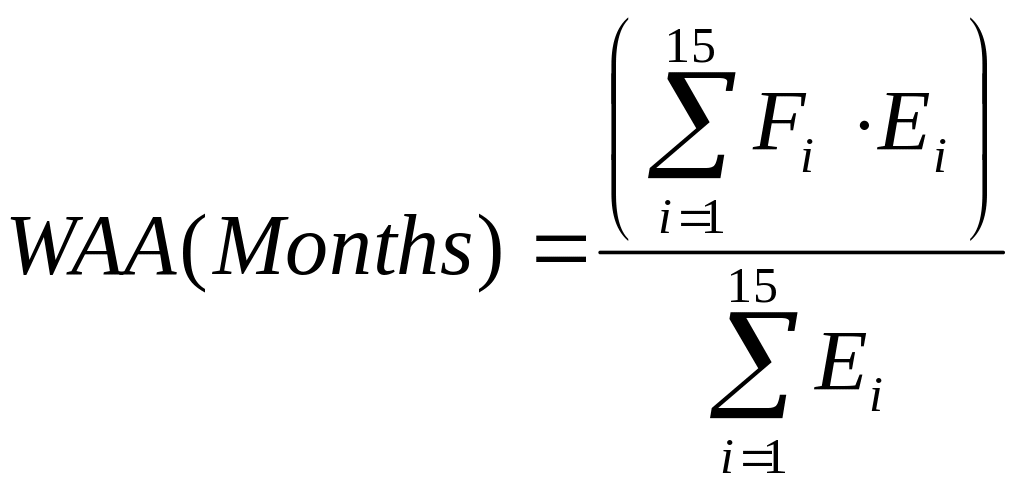
where Fi and Ei are the weighted average age (months) and EAD ($) reported in columns F and E, respectively, for the ith PD range in item numbers 1 through 15 of this schedule.
In column G, the EAD-weighted average LGD (WALGD) in percentage terms is calculated as follows:
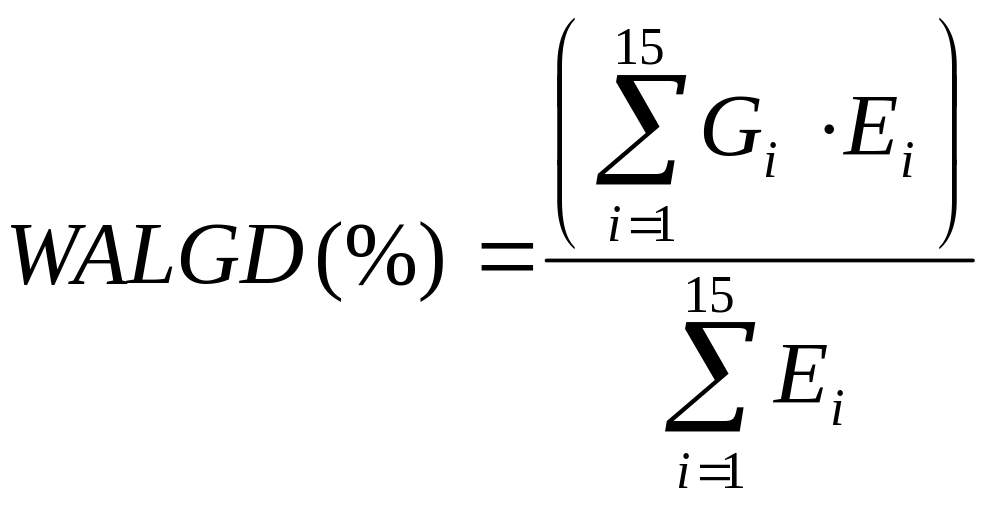
where Gi and Ei are the weighted average LGD (%) and EAD ($) reported in columns G and E, respectively, for the ith PD range in item numbers 1 through 15 of this schedule.
In column O, report the EAD-weighted average bureau score (WABS), rounded to the nearest whole number, using the following calculation:
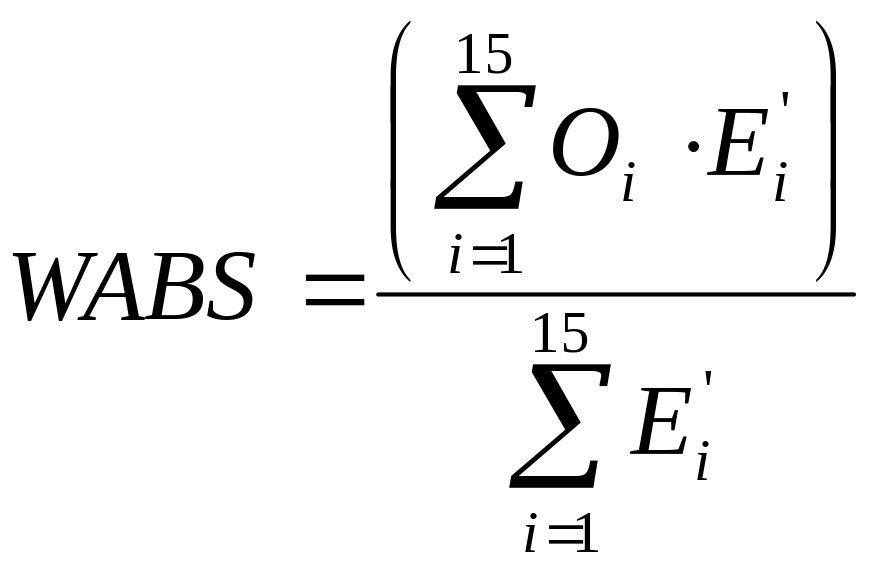
where
Oi
is the weighted average bureau score reported in column O and
![]() is
the EAD ($) of exposures with
a bureau score available,
for the ith
PD range in item numbers 1 through 15 of this schedule. The EAD
reported in column Ei
will be greater or equal to the EAD of exposures with a bureau score
available,
is
the EAD ($) of exposures with
a bureau score available,
for the ith
PD range in item numbers 1 through 15 of this schedule. The EAD
reported in column Ei
will be greater or equal to the EAD of exposures with a bureau score
available,![]() .
.
In columns B, C, D, E, H, I, J, K, L, M, N, and P, the sums are calculated as the total of amounts reported in item numbers 1 through 15 of this schedule for each of these respective columns.
17 Report the risk-weighted assets of non-material portfolios reportable in this schedule but not included in the above cells.
18 Report the name of the credit bureau or credit scoring system used to produce the values in column O.
Schedule L – Retail Exposures – Residential Mortgage – Closed-end Junior Lien Exposures
Report all residential mortgage exposures that (1) are secured by liens subordinate to any other lien, and (2) are not revolving.
Item No. Instructions
1-15 In column A, report the weighted average PD of all segments of exposures applicable to this section as noted above, whose PD falls within each range indicated. Cell A-15 equals 100.
In column B, report the total number of exposures in all segments included in this row for column A.
In column C, report the total balance sheet amount of exposures within the segments included in this row for column A.
In column D, report the dollar volume of available but undrawn balances of exposures within the segments included in this row for column A. Include undrawn commitments to lend, including available negative amortization and unfunded mortgage commitments.
In column E, report the total EAD of segments of exposures included in this row for column A.
In column F, report the weighted average age in months of exposures in the segments included in this row for column A.
In column G, report the weighted average LGD of exposures in the segments included in this row for column A.
In column H, report total risk-weighted assets associated with all segments of exposures included in this row for column A.
In column I, report the dollar volume of ECL, after consideration of credit risk mitigation, for segments of exposures included in this row for column A.
In column J, report the EAD of exposures included in this row for column A that have less than a 70% LTV.
In column K, report the EAD of exposures included in this row for column A that have at least a 70% but less than 80% LTV.
In column L, report the EAD of exposures included in this row for column A that have at least an 80% but less than 90% LTV.
In column M, report the EAD of exposures included in this row for column A that have at least a 90% but less than 100% LTV.
In column N, report the EAD of exposures included in this row for column A that have an LTV greater than or equal to 100%.
In column O, report the weighted average credit risk score of exposures in the segments included in this row for column A.
In column P, report the EAD of accounts that are included in the segments reported in this row where the LTV has been updated since the last report date, that is, the updated LTV is based upon a refreshed assessment of the collateral value. If LTVs were not updated for any accounts in the segments reported in the row since the last report date, report 0.
16 In column A, the EAD-weighted average PD (WAPD) in percentage terms is calculated as follows:

where Ai and Ei are the weighted average PD (%) and EAD ($) reported in columns A and E, respectively, for the ith PD range in item numbers 1 through 15 of this schedule. Note that A15 equals 100.
In column F, the EAD-weighted average age (WAA) in months is calculated as follows:

where Fi and Ei are the weighted average age (months) and EAD ($) reported in columns F and E, respectively, for the ith PD range in item numbers 1 through 15 of this schedule.
In column G, the EAD-weighted average LGD (WALGD) in percentage terms is calculated as follows:
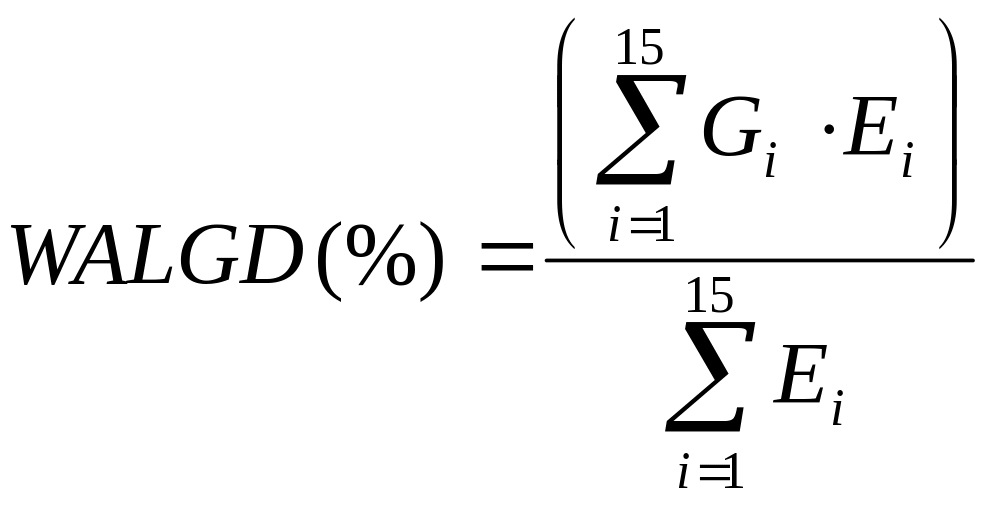
where Gi and Ei are the weighted average LGD (%) and EAD ($) reported in columns G and E, respectively, for the ith PD range in item numbers 1 through 15 of this schedule.
In column O, report the EAD-weighted average bureau score (WABS), rounded to the nearest whole number, using the following calculation:

where
Oi
is the weighted average bureau score reported in column O and
![]() is
the EAD ($) of exposures with
a bureau score available,
for the ith
PD range in item numbers 1 through 15 of this schedule. The EAD
reported in column Ei
will be greater or equal to the EAD of exposures with a bureau score
available,
is
the EAD ($) of exposures with
a bureau score available,
for the ith
PD range in item numbers 1 through 15 of this schedule. The EAD
reported in column Ei
will be greater or equal to the EAD of exposures with a bureau score
available,![]() .
.
In columns B, C, D, E, H, I, J, K, L, M, N, and P, the sums are calculated as the total of amounts reported in item numbers 1 through 15 of this schedule for each of these respective columns.
17 Report the risk-weighted assets of non-material portfolios reportable in this schedule but not included in the above cells.
18 Report the name of the credit bureau or credit scoring system used to produce the values in column O.
Schedule M – Retail Exposures – Residential Mortgage – Revolving Exposures
Report all residential mortgage exposures that are revolving.
Item No. Instructions
1-15 In column A, report the weighted average PD of all segments of exposures applicable to this section as noted above, whose PD falls within each range indicated. Cell A-15 equals 100.
In column B, report the total number of exposures in all segments included in this row for column A.
In column C, report the total balance sheet amount of exposures within the segments included in this row for column A.
In column D, report the dollar volume of available but undrawn balances of exposures within the segments included in this row for column A. Include undrawn commitments to lend, including available negative amortization and unfunded mortgage commitments.
In column E, report the total EAD of segments of exposures included in this row for column A.
In column F, report the weighted average age in months of exposures in the segments included in this row for column A.
In column G, report the weighted average LGD of exposures in the segments included in this row for column A.
In column H, report total risk-weighted assets associated with all segments of exposures included in this row for column A.
In column I, report the dollar volume of ECL, after consideration of credit risk mitigation, for segments of exposures included in this row for column A.
In column J, report the EAD of exposures included in this row for column A that have less than a 70% LTV.
In column K, report the EAD of exposures included in this row for column A that have at least a 70% but less than 80% LTV.
In column L, report the EAD of exposures included in this row for column A that have at least an 80% but less than 90% LTV.
In column M, report the EAD of exposures included in this row for column A that have at least a 90% but less than 100% LTV.
In column N, report the EAD of exposures included in this row for column A that have an LTV greater than or equal to 100%.
In column O, report the weighted average credit risk score of exposures in the segments included in this row for column A.
In column P, report the EAD of accounts that are included in the segments reported in this row where the LTV has been updated since the last report date, that is, the updated LTV is based upon a refreshed assessment of the collateral value. If LTVs were not updated for any accounts in the segments reported in the row since the last report date, report 0.
16 In column A, the EAD-weighted average PD (WAPD) in percentage terms is calculated as follows:
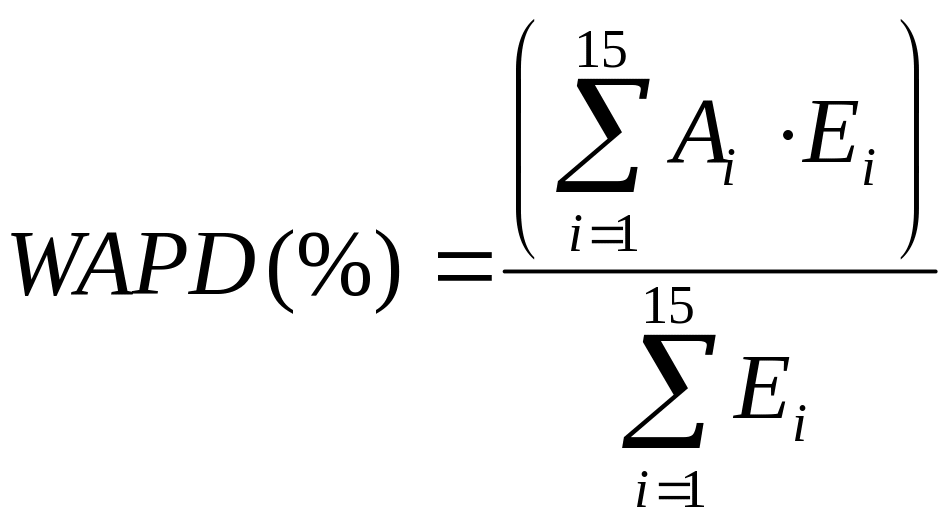
where Ai and Ei are the weighted average PD (%) and EAD ($) reported in columns A and E, respectively, for the ith PD range in item numbers 1 through 15 of this schedule. Note that A15 equals 100.
In column F, the EAD-weighted average age (WAA) in months is calculated as follows:

where Fi and Ei are the weighted average age (months) and EAD ($) reported in columns F and E, respectively, for the ith PD range in item numbers 1 through 15 of this schedule.
In column G, the EAD-weighted average LGD (WALGD) in percentage terms is calculated as follows:
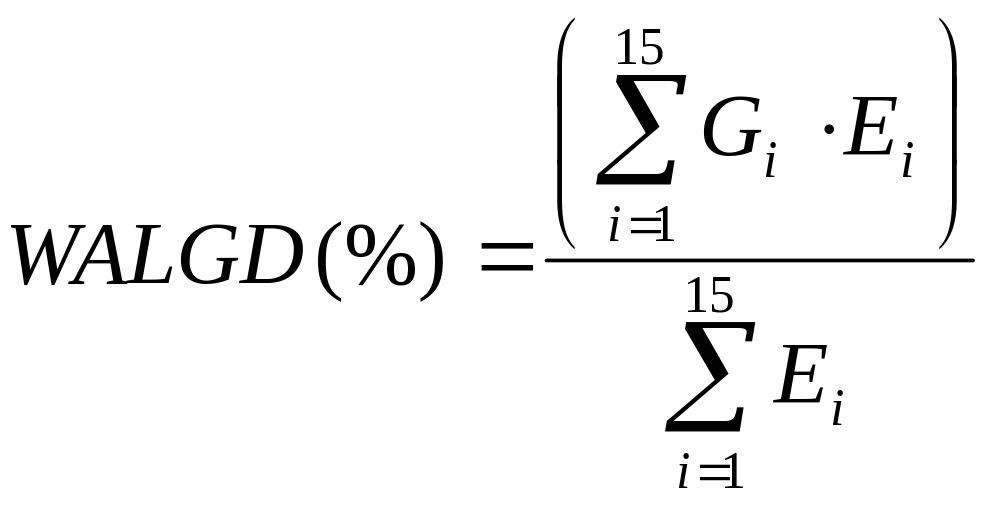
where Gi and Ei are the weighted average LGD (%) and EAD ($) reported in columns G and E, respectively, for the ith PD range in item numbers 1 through 15 of this schedule.
In column O, report the EAD-weighted average bureau score (WABS), rounded to the nearest whole number, using the following calculation:

where
Oi
is the weighted average bureau score reported in column O and
![]() is
the EAD ($) of exposures with
a bureau score available,
for the ith
PD range in item numbers 1 through 15 of this schedule. The EAD
reported in column Ei
will be greater or equal to the EAD of exposures with a bureau score
available,
is
the EAD ($) of exposures with
a bureau score available,
for the ith
PD range in item numbers 1 through 15 of this schedule. The EAD
reported in column Ei
will be greater or equal to the EAD of exposures with a bureau score
available,![]() .
.
In columns B, C, D, E, H, I, J, K, L, M, N, and P, the sums are calculated as the total of amounts reported in item numbers 1 through 15 of this schedule for each of these respective columns.
17 Report the risk-weighted assets of non-material portfolios reportable in this schedule but not included in the above cells.
18 Report the name of the credit bureau or credit scoring system used to produce the values in column O.
Schedule N – Retail Exposures – Qualifying Revolving Exposures
Report all qualifying revolving exposures.
Item No. Instructions
1-15 In column A, report the weighted average PD of the segments whose PDs fall within each of the PD ranges indicated. Cell A-15 equals 100.
In column B, report the total number of exposures in all segments included in this row for column A.
In column C, report the total balance sheet amount of exposures within the segments included in this row for column A.
In column D, report the dollar amount of available but undrawn balances of exposures within the segments included in this row for column A.
In column E, report the total EAD of segments of exposures included in this row for column A.
In column F, report the total EAD for the exposures in the segments included in this row for column A that are less than 2 years old.
In column G, report the weighted average LGD of exposures in the segments included in this row for column A.
In column H, report total risk-weighted assets associated with all segments of exposures included in this row for column A.
In column I, report the dollar amount of ECL, after consideration of credit risk mitigation, for segments of exposures included in this row for column A.
In column J, report the weighted average credit risk score of exposures in the segments included in this row for column A.
16 In column A, the EAD-weighted average PD (WAPD) in percentage terms is calculated as follows:
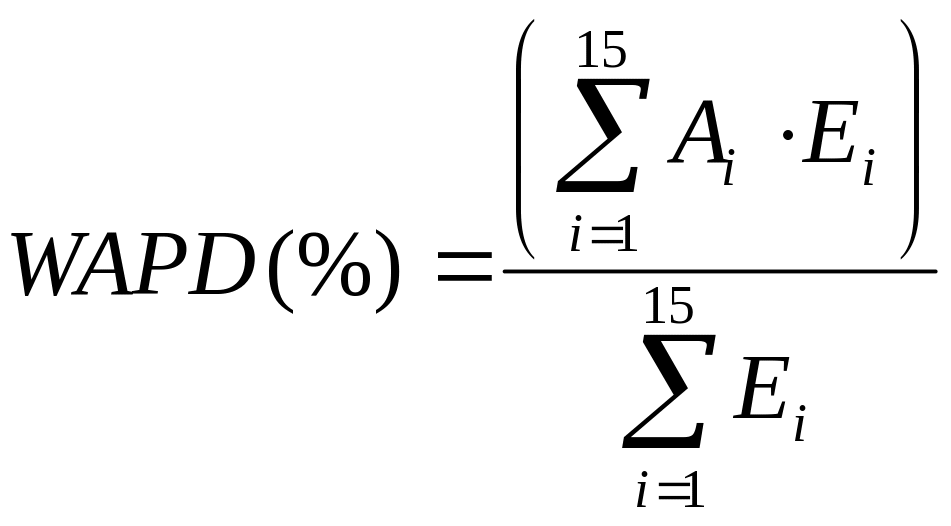
where Ai and Ei are the weighted average PD (%) and EAD ($) reported in columns A and E, respectively, for the ith PD range in item numbers 1 through 15 of this schedule. Note that A15 equals 100.
In column G, the EAD-weighted average LGD (WALGD) in percentage terms is calculated as follows:
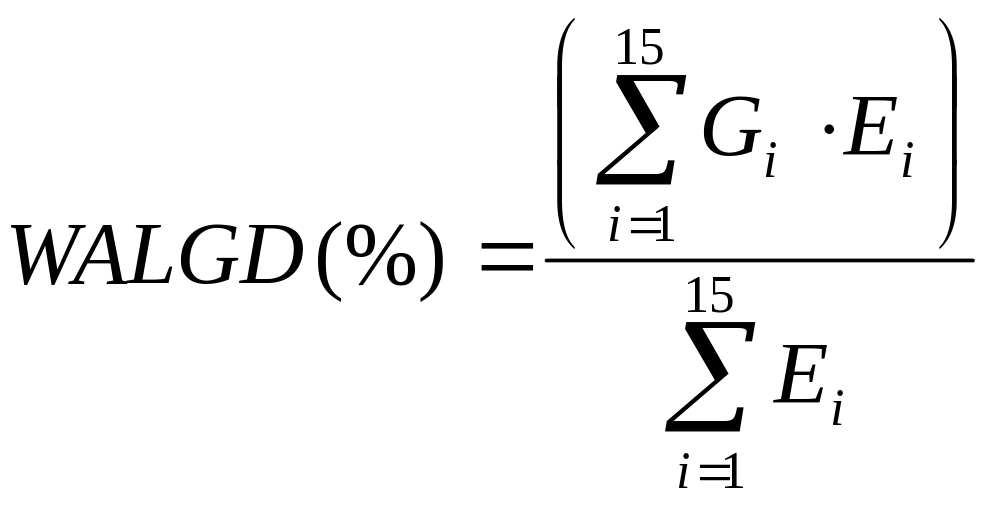
where Gi and Ei are the weighted average LGD (%) and EAD ($) reported in columns G and E, respectively, for the ith PD range in item numbers 1 through 15 of this schedule.
In column J, report the EAD-weighted average bureau score (WABS), rounded to the nearest whole number, using the following calculation:
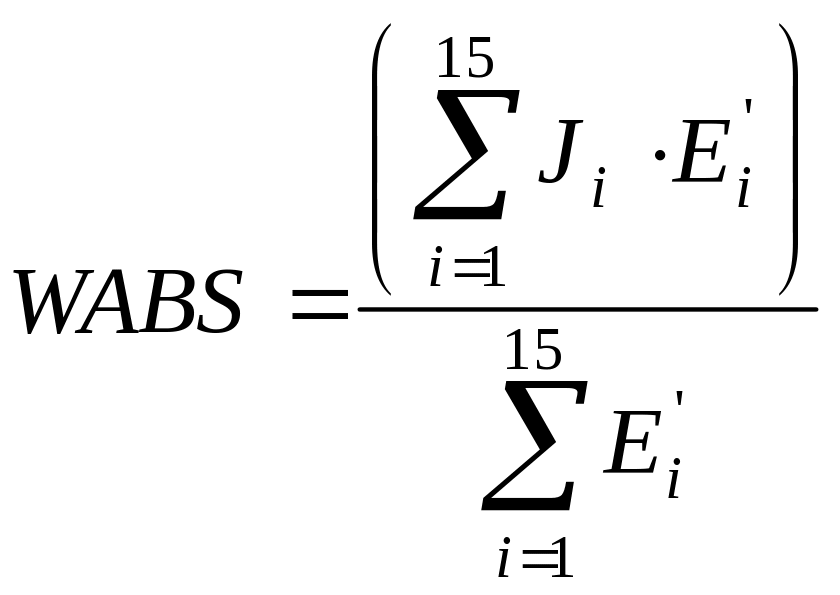
where
Ji
is the weighted average bureau score reported in column J and
![]() is
the EAD ($) of exposures with
a bureau score available,
for the ith
PD range in item numbers 1 through 15 of this schedule. The EAD
reported in column Ei
will be greater or equal to the EAD of exposures with a bureau score
available,
is
the EAD ($) of exposures with
a bureau score available,
for the ith
PD range in item numbers 1 through 15 of this schedule. The EAD
reported in column Ei
will be greater or equal to the EAD of exposures with a bureau score
available,![]() .
.
In columns B, C, D, E, F, H, and I, the sums are calculated as the total of amounts reported in item numbers 1 through 15 of this schedule for each of these respective columns.
17 Report the risk-weighted assets of non-material portfolios reportable in this schedule but not included in the above cells.
18 Report the name of the credit bureau or credit scoring system used to produce the values in column J.
Schedule O – Retail Exposures – Other Retail Exposures
Report other retail exposures.
Item No. Instructions
1-15 In column A, report the weighted average PD of the segments whose PDs fall within each of the PD ranges indicated. Cell A-15 equals 100.
In column B, report the total number of exposures in all segments included in this row for column A.
In column C, report the total balance sheet amount of exposures within the segments included in this row for column A.
In column D, report the dollar amount of available but undrawn balances of exposures within the segments included in this row for column A.
In column E, report the total EAD of segments of exposures included in this row for column A.
In column F, report the total EAD for the exposures in the segments included in this row for column A that are less than 2 years old.
In column G, report the weighted average LGD of exposures in the segments included in this row for column A.
In column H, report total risk-weighted assets associated with all segments of exposures included in this row for column A.
In column I, report the dollar amount of ECL, after consideration of credit risk mitigation, for segments of exposures included in this row for column A.
In column J, report the weighted average credit risk score of exposures in the segments included in this row for column A.
16 In column A, the EAD-weighted average PD (WAPD) in percentage terms is calculated as follows:
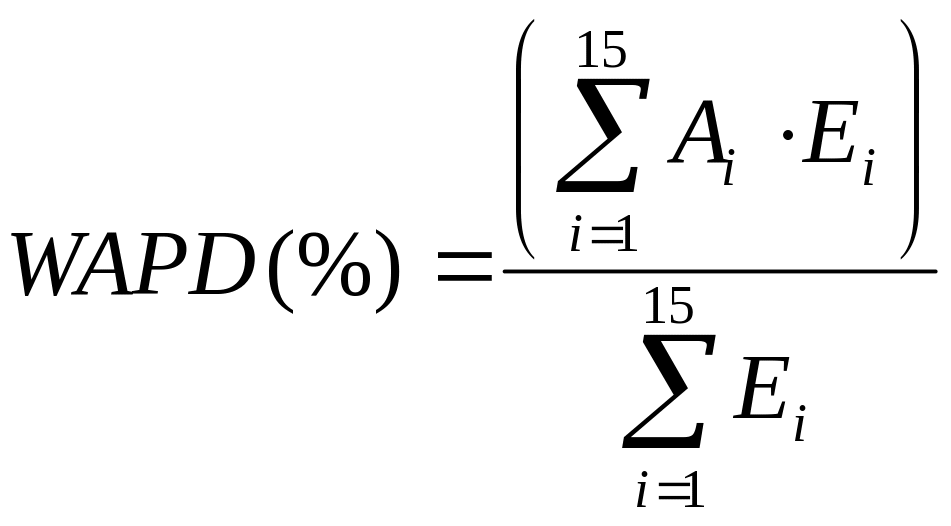
where Ai and Ei are the weighted average PD (%) and EAD ($) reported in columns A and E, respectively, for the ith PD range in item numbers 1 through 15 of this schedule. Note that A15 equals 100.
In column G, the EAD-weighted average LGD (WALGD) in percentage terms is calculated as follows:
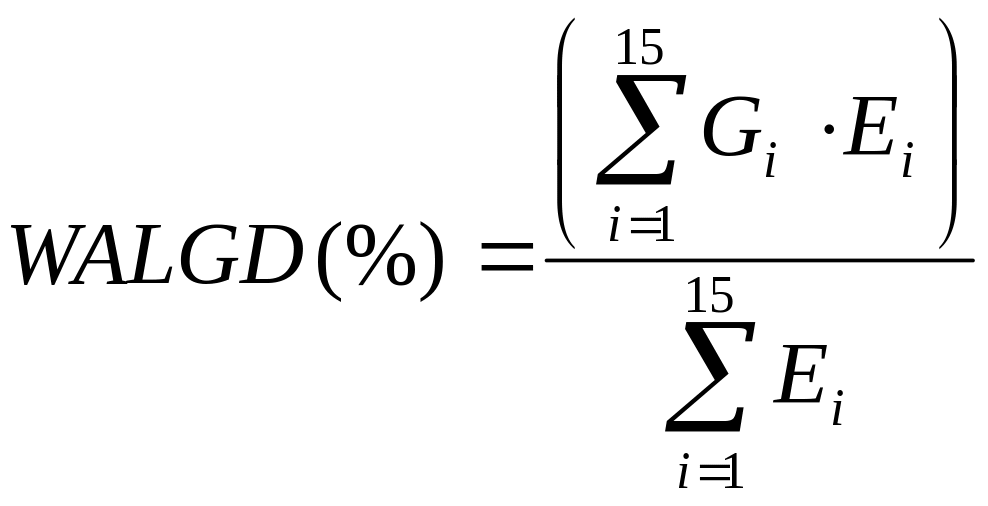
where Gi and Ei are the weighted average LGD (%) and EAD ($) reported in columns G and E, respectively, for the ith PD range in item numbers 1 through 15 of this schedule.
In column J, report the EAD-weighted average bureau score (WABS), rounded to the nearest whole number, using the following calculation:
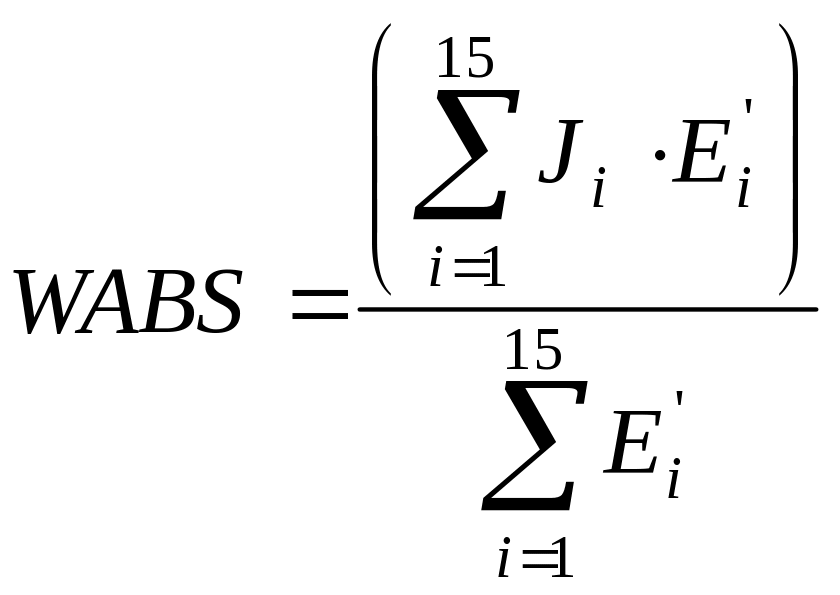
where
Ji
is the weighted average bureau score reported in column J and
![]() is
the EAD ($) of exposures with
a bureau score available,
for the ith
PD range in item numbers 1 through 15 of this schedule. The EAD
reported in column Ei
will be greater or equal to the EAD of exposures with a bureau score
available,
is
the EAD ($) of exposures with
a bureau score available,
for the ith
PD range in item numbers 1 through 15 of this schedule. The EAD
reported in column Ei
will be greater or equal to the EAD of exposures with a bureau score
available,![]() .
.
In columns B, C, D, E, F, H, and I, the sums are calculated as the total of amounts reported in item numbers 1 through 15 of this schedule for each of these respective columns.
17 Report the risk-weighted assets of non-material portfolios reportable in this schedule but not included in the above cells.
18 Report the name of the credit bureau or credit scoring system used to produce the values in column J.
Schedules P and Q – Securitization Exposures
General Instructions
Definitions. Apply the definitions from the final rule to the following terms: (1) securitization exposure; (2) securitization; (3) early amortization provision; (4) exposure at default (EAD); (5) investors’ interest EAD; and (6) synthetic securitization.
The Ratings-based Approach (RBA), Internal Assessment Approach (IAA), and Supervisory Formula Approach (SFA) are described in sections 43, 44, and 45, respectively, of the final rule.
Schedule P - Exposures Subject to Ratings-Based or Internal Assessment Approaches
Item No. Instructions
1-4 Report the aggregate amount of securitization exposures (consistent with section 42(c) of the final rule) in each line item that correspond to a particular rating category, separating those subject to the Ratings-based Approach (RBA) from those subject to the Internal Assessment Approach (IAA). Report risk weighted assets for each line item in the last column. Do not include exposures that require deduction.
5 In columns A, B, and C, the sums are calculated as the total of amounts reported in item numbers 1 through 4 of this schedule for each of these respective columns. [Note: these totals do not include amounts related to long-term exposures rated more than one category below investment grade, and short-term exposures rated below the third highest grade.]
Schedule Q – Securitization Exposures – Additional Detail
Item No. Instructions
1 In column C, report the aggregate amount that must be deducted for exposures under the RBA and IAA approaches. Do not use columns A or B.
2 In column C, report the aggregate amount that must be deducted for all other securitization exposures (except those exposures deducted under the SFA and reported in item 3 below). Do not use columns A or B.
3 In column A, report the amount of exposures under the SFA.
In column B, report the risk weight assets associated with the exposures in column A.
In column C, report the amount that must be deducted due to a 1250 percent or greater risk weight under the SFA.
4 In column A, report the total exposure to synthetic securitizations.
In column B, report the amount of risk weighted assets associated with synthetic securitizations.
In column C, report deductions associated with synthetic securitizations.
5 In column A, report the EAD associated with the investors’ interest in revolving retail credit line (e.g., individual credit line) securitizations.
In column B, report the risk weighted assets associated with the investors’ interest in revolving retail credit line (e.g., individual credit line) securitizations.
6 In column A, report the EAD associated with the investors’ interest in revolving non-retail credit line securitizations.
In column B, report the risk weighted assets associated with the investors’ interest in revolving non-retail credit line securitizations.
Schedule R – Equity Exposures
General Instructions
Definitions. Apply the definitions provided in the final rule for the following terms: (1) publicly traded; (2) investment fund; and (3) equity exposure.
The following terms are described in section 52 of the final rule: (1) community development equity exposures; (2) hedge pairs and measures of an effective hedge; and (3) non-significant equity exposures.
The term adjusted carrying value is described in section 51 of the final rule.
The Simple Risk Weight Approach (SRWA) and the Internal Models Approach (IMA) are described in sections 52 and 53, respectively, of the final rule. The effective and ineffective portion of a hedge pair are described in section 52(c) of the final rule.
Item No. Instructions
Items 1 through 4 should be completed by all banks with equity exposures.
1 Total Equity Exposures. In column A, report the aggregate adjusted carrying value of equity exposures that are subject to Part VI of the final rule. Do not include equity exposures subject to the market risk capital framework.
2 0% Risk Weight. In column A, report the adjusted carrying value of equity exposures that are sovereign exposures or exposures to the Bank for International Settlements, the International Monetary Fund, the European Commission, the European central bank or a multilateral development bank, to which the bank assigns a rating grade associated with a PD of less than 0.03 percent.
In column B, report 0.
3 20% Risk Weight. In column A, report the adjusted carrying value of equity exposures to a Federal Home Loan Bank and Farmer Mac.
In column B, report 20 percent of the amount in column A for this item.
4 Community Development Equity Exposures. In column A, report the adjusted carrying value of community development equity exposures.
In column B, report 100 percent of the amount in column A for this item.
Simple Risk Weight Approach (SRWA)
Items 5 through 10 should be completed by banks that use the simple risk weight approach (SRWA). Items 8 and 9 should be completed by banks that use the IMA for only publicly traded equity exposures.
5 Effective Portion of Hedge Pairs. In column A, report the effective portion of each hedge pair.
In column B, report 100 percent of the amount in column A for this item.
6 Non-Significant Equity Exposures. In column A, report the adjusted carrying value of non-significant equity exposures (excluding amounts reported in column A, items 2 through 5) up to 10 percent of tier 1 plus tier 2 capital.
In column B, report 100 percent of the amount in column A for this item.
7 Publicly Traded Equity Exposures Under the SRWA. In column A, report the adjusted carrying value of the bank’s publicly traded equity exposures not included in column A, items 2 through 6, and not subject to a 600 percent risk weight per the final rule, including the ineffective portion of each hedge pair.
In column B, report 300 percent of the amount in column A for this item.
8 Non-Publicly Traded Equity Exposures Under the SRWA. In column A, report the adjusted carrying value of the bank’s non-publicly traded equity exposures not included in items 2 through 6, and not subject to a 600 percent risk weight per the final rule.
In column B, report 400 percent of the amount in column A for this item.
9 600% Risk Weight Equity Exposures Under the SRWA. In column A, report the adjusted carrying value of the bank’s equity exposures subject to a 600 percent risk weight under paragraph (b)(6) of section 52 of the final rule.
In column B, report 600 percent of the amount in column A for this item.
10 Total Risk Weighted Assets (RWA) Under the SRWA. In column B, report the sum of amounts in column B, items 2 through 9.
Equity Exposures to Investment Funds
Items 11 through 15 should be completed by all banks with equity exposures to investment funds.
11 Full Look-through Approach. In column A, report the adjusted carrying value of all equity exposures to investment funds to which the bank applies the full look-through approach as described in paragraph (b) of section 54 of the final rule.
In column B, report the risk weighted assets of the amount in column A for this item.
12 Simple Modified Look-through Approach. In column A, report the adjusted carrying value of all equity exposures to investment funds to which the bank applies the simple modified look-through approach as described in paragraph (c) of section 54 of the final rule.
In column B, report the risk weighted assets for the amount in column A for this item.
13 Alternative Modified Look-through Approach. In column A, report the adjusted carrying value of all equity exposures to investment funds for which the bank applies the alternative modified look-through approach as described in paragraph (d) of section 54 of the final rule.
In column B, report the risk weighted assets for the amount in column A for this item.
14 Money Market Fund Approach. In column A, report the adjusted carrying value of all equity exposures to investment funds that qualify for the Money Market Fund Approach described in paragraph (e) of section 54 of the final rule.
In column B, report 7 percent of the amount in column A for this item.
15 Total Risk Weighted Assets for Investment Funds. In column B, report the sum of amounts in column B, items 11 through 14.
16 Total: SRWA. Complete this item if the SRWA is used. In column B, report the sum of column B, items 10 and 15.
Full Internal Models Approach (Full IMA)
Items 17 through 22 apply to banks that use the internal models approach for both publicly traded and non-publicly traded equity exposures.
17 Estimate of Potential Losses on Equity Exposures. In column A, report the estimated potential losses on the bank’s equity exposures, excluding those exposures reported in column A, items 2 through 4 of this schedule and equity exposures to investment funds.
In column B, report 12.5 times the amount in column A for this item.
Floors for Full IMA
18 Publicly Traded. In column A, report the sum of (i) the aggregated adjusted carrying value of the bank’s publicly traded equity exposures that do not belong to a hedge pair, are not reported in column A, items 2 through 4 of this schedule, and are not equity exposures to an investment fund, and (ii) the aggregate ineffective portion of all hedge pairs.
In column B, report 200 percent of the amount in column A for this item.
19 Non-publicly Traded. In column A, report the aggregated adjusted carrying value of the bank’s equity exposures that are not publicly traded, are not reported in column A, items 2 through 4 of this schedule, and are not equity exposures to an investment fund.
In column B, report 300 percent of the amount in column A for this item.
20 Risk Weighted Asset Floors. In column B, report the sum of column B, items 18 and 19.
21 Total Risk Weighted Assets – Full IMA. In column B, report the larger of column B, item 17 or column B, item 20.
22 Total: Full IMA. In column B, report the sum of column B, items 3, 4, 15, and 21
Publicly Traded Internal Models Approach (Partial IMA)
Items 23 through 26 apply to banks that use the IMA for only publicly traded equity exposures. These banks should also compute items 8 and 9 of this schedule.
23 Estimate of Potential Losses on Publicly Traded Equity Exposures. In column A, report the estimated potential losses on the bank’s publicly traded equity exposures, excluding those reported in column A, items 2, 3, 4, 8, and 9 of this schedule, and equity exposures to investment funds.
In column B, report 12.5 times the amount in column A for this item.
Floor for Partial IMA
24 Publicly Traded. In column A, report sum of (i) the aggregated adjusted carrying value of the bank’s publicly traded equity exposures that do not belong to a hedge pair, are not reported in column A, items 2 through 4 of this schedule, and are not equity exposures to an investment fund, and (ii) the ineffective portion of all hedge pairs.
In column B, report 200 percent of the amount in column A for this item.
25 Total Risk Weighted Assets – Partial IMA. In column B, report the larger of column B, item 23 or column B, item 24.
26 Total: Partial IMA, Partial SRWA. In column B, report the sum of column B, items 3, 4, 8, 9, 15 and 25.
Schedule S – Operational Risk
Operational Risk Capital
Definitions. Apply the definitions provided in the final rule for the following terms: (1) business environment and internal control factors; (2) dependence; (3) eligible operational risk offsets; (4) expected operational loss; (5) operational loss event; (6) operational risk; (7) operational risk exposure; (8) GAAP; (9) scenario analysis; (10) unexpected operational loss; and (11) unit of measure. Frequency Distribution means the statistical distribution used to calculate the frequency of losses. Severity Distribution means the statistical distribution used to calculate the severity of losses.
All line items described in this schedule should be completed based on available data. The agencies recognize that certain circumstances may pose reporting challenges for banks. For example, the inherent flexibility of the Advanced Measurement Approach (AMA) or a bank’s use, with prior written supervisory approval, of an alternative operational risk quantification system may result in a bank having limited data to report for certain line items. In determining its response to each line item, a bank should carefully review the instructions and report the information it has available. In instances where a bank does not have information to report for a particular line item, it should report either "0" or "N/A" (not applicable) as appropriate. A response of “0” generally indicates that a bank could report information for a line item based on its approach, but does not have anything to report for the current period. A response of “N/A” generally indicates that a bank does not have any relevant information to report for a particular line item based on its approach for measuring its risk-based capital requirement for operational risk.
Item No. Caption and Instructions
Public Items
1 Risk-based Capital Requirement for Operational Risk. Report the dollar amount of the risk-based capital requirement for operational risk pursuant to the requirements of the final rule.
2 Is item 1 generated from an "alternative operational risk quantification system?" Report whether the risk-based capital figure reported in item 1 results from an “alternative operational risk quantification system” (as discussed in section 22(h)(3)(ii) of the final rule) by indicating “1” for (yes) or “0” for (no) for this item.
Confidential Items
Expected Operational Loss (EOL) and Eligible Operational Risk Offsets
3 Expected Operational Loss (EOL). Report the dollar amount of the expected value of the distribution of potential aggregate operational losses, as generated by the bank’s operational risk quantification system using a one-year horizon.
4 Total Eligible Operational Risk Offsets.
4a Eligible GAAP reserves. Report the dollar amount of reserves calculated in a manner consistent with GAAP.
4b Other eligible offsets. Report the dollar amount of offsets approved by the institution’s supervisor outside of GAAP reserves reported in item 4a above.
Total Risk-based Capital Requirement for Operational Risk without:
The effects of each of the following three adjustments on risk-based capital for operational risk should be calculated independently (e.g. item 7 should only exclude Risk Mitigants from the calculation, and should continue to include adjustments for dependence assumptions and those related to business environment and internal control factors).
5 Dependence Assumptions. Report the risk-based capital requirement for operational risk excluding the effects of dependence assumptions.
6 Adjustments Reflecting Business Environment and Internal Control Factors. Report the risk-based capital requirement for operational risk excluding the effects of qualitative adjustments that account for business environment and internal control factors.
7 Risk Mitigants (e.g., insurance). Report the risk-based capital requirement for operational risk excluding the effects of qualifying operational risk mitigants, as discussed in section 61 of the final rule.
Internal Operational Loss Event Data Characteristics
8 Date ranges of internal operational loss event data used in modeling operational risk capital. For items 8a through 8d, all dates should be expressed in the MM/YYYY format on the schedule.
8a Starting date for frequency distribution (if applicable). Report the earliest date relevant to the internal operational loss event data used in modeling the frequency distribution for operational risk capital. If such a distribution is not used, report “N/A” for this item.
8b Ending date for frequency distribution (if applicable). Report the latest date relevant to the internal operational loss event data used in modeling the frequency distribution for operational risk capital. If such a distribution is not used, report “N/A” for this item.
8c Starting date for severity distribution (if applicable). Report the earliest date relevant to the internal operational loss event data used in modeling the severity distribution for operational risk capital. If such a distribution is not used, report “N/A” for this item.
8d Ending date for severity distribution (if applicable). Report the latest date relevant to the internal operational loss event data used in modeling the severity distribution for operational risk capital. If such a distribution is not used, report “N/A” for this item.
9 Highest dollar threshold applied in modeling internal operational loss event data. Report the dollar threshold that is used to exclude smaller internal operational loss event data from operational risk capital modeling. If more than one threshold is applied in the modeling process, report the highest threshold used. If no thresholds are used, report “0” for this item.
10 Does the dollar threshold change across units of measure? Report whether the thresholds for the internal loss data used in modeling operational risk capital differ across units of measure by indicating “1” for (yes) or “0” for (no) for this item. As defined in the final rule, unit of measure is the level (for example, organizational unit or operational loss event type) at which the bank’s operational risk quantification system generates a separate distribution of potential operational losses.
11 Total number of loss events. Report the total number of internal loss events used in the model to determine the risk-based capital requirement for operational risk. A loss event may encompass one loss transaction or may comprise multiple loss transactions all related to the same event. For example, individual losses of $2,000, $6,000, and $12,000 that all relate to a single loss event should be considered one loss (amounting to $20,000) for purposes of calculating this item. Conversely, losses that do not relate to the same event should be considered separate loss events. For example, a bank may group losses together for certain purposes (e.g., because of similarity in causal factors), but these losses should be counted separately for reporting purposes if they do not relate to the same event.
12 Total dollar amount of loss events. Report the total dollar amount of internal loss events used in the model to determine the risk-based capital requirement for operational risk.
13 Dollar amount of largest loss event. Report the dollar value of the largest single internal loss event used in the model to determine the risk-based capital requirement for operational risk. The largest internal loss event should include all the loss transactions related to the single event.
14 Number of loss events in the following ranges (e.g., ≥ $10,000 and < $100,000).
14a. Less than $10,000
14b. $10,000 to $100,000
14c. $100,000 to $1 Million
14d. $1 Million to $10 Million
14e. $10 Million to $100 Million
14f. $100 Million to $1 Billion
14g. $1 Billion or Greater
For each range, report the total number of internal losses used in the model to determine the risk-based capital requirement for operational risk. If the bank has set a threshold for its internal loss event data capture and events below that threshold are not captured, that should be reflected by marking “0” in the ranges that are below the threshold. In addition, if no losses have been experienced in a particular range, report “0” for that item.
The number of losses should be calculated on an event basis to ensure that related losses are counted as a single loss.
15 Total dollar amount of losses in the following ranges (e.g., ≥ $10,000 and < $100,000).
15a. Less than $10,000
15b. $10,000 to $100,000
15c. $100,000 to $1 Million
15d. $1 Million to $10 Million
15e. $10 Million to $100 Million
15f. $100 Million to $1 Billion
15g. $1 Billion or Greater
For each range, report the total dollar amount of internal losses used in the model to determine the risk-based capital requirement for operational risk. If the bank has set a threshold for its internal loss event data capture and events below that threshold are not captured, that should be reflected by marking “0” in the ranges that are below the threshold. In addition, if no losses have been experienced in a particular range, report “0” for that item.
The dollar amount of losses should be calculated on an event basis to ensure that related losses are summed for purposes of calculating the total dollar amount for each range.
Scenario Analysis
16 How many individual scenarios were used in calculating the risk-based capital requirement for operational risk? Report the total number of scenarios that were used as direct inputs in the model to determine the risk-based capital requirement for operational risk.
17 What is the dollar value of the largest individual scenario? Report the dollar value of the largest scenario used as a direct input in the model to determine the risk-based capital requirement for operational risk.
18 Number of scenarios in the following ranges (e.g., ≥ $1 Million and < $10 Million).
Based on the response to item 16, for each range, report the total number of scenarios used as direct inputs into the model to determine the risk-based capital requirement. Report “0” for any ranges where there were no scenarios or they do not apply.
18a. Less than $1 million
18b. $1 Million to $10 Million
18c. $10 Million to $100 Million
18d. $100 Million to $500 Million
18e. $500 Million to $1 Billion
18f. $1 Billion or Greater
Distributional Assumptions
19 How many units of measure were used in calculating the risk-based capital requirement for operational risk? Report the number of units of measure for which a separate distribution of potential operational losses is generated by the institution’s operational risk quantification system.
20 Frequency Distribution: Across how many individual units of measure did the choice of frequency distribution change since the last reporting period? Report the total number of units of measure for which the statistical distribution(s) used this reporting period to estimate loss frequency differs from those used in the prior reporting period. This refers to changes in the distribution type. If frequency distributions are not used, report “N/A” for this item.
21 Severity Distribution: Across how many individual units of measure did the choice of severity distribution change since the last reporting period? Report the total number of units of measure for which the statistical distribution(s) used this reporting period to estimate loss severity differs from those used in the prior reporting period. This refers to changes in the distribution type. If frequency distributions are not used, report “N/A” for this item.
Loss Caps
Items 22 through 24 solicit information on the extent to which such loss caps are used and the levels at which those caps are set.
22 How many loss caps are used in calculating the risk-based capital requirement for operational risk? Report the number of loss caps used to limit loss size in the quantification process for determining the risk-based capital requirement for operational risk. If loss caps are not used, report “0” for this item.
23 What is the dollar amount of the smallest cap used (if applicable)? Report the dollar amount of the smallest cap used to limit loss size in the quantification process for determining the risk-based capital requirement for operational risk. If “0” is reported in item 22, report “N/A” for this item.
24 What is the dollar amount of the largest cap used (if applicable)? Report the dollar amount of the largest cap used to limit loss size in the quantification process for determining the risk-based capital requirement for operational risk. If “0” is reported in item 22, report “N/A” for this item.
1 See 72 FR 69288.
FFIEC 101
| File Type | application/msword |
| File Title | AIRB Reporting Schedules A through V |
| Author | sburton |
| Last Modified By | Fed edits |
| File Modified | 2008-04-23 |
| File Created | 2008-04-23 |
© 2025 OMB.report | Privacy Policy